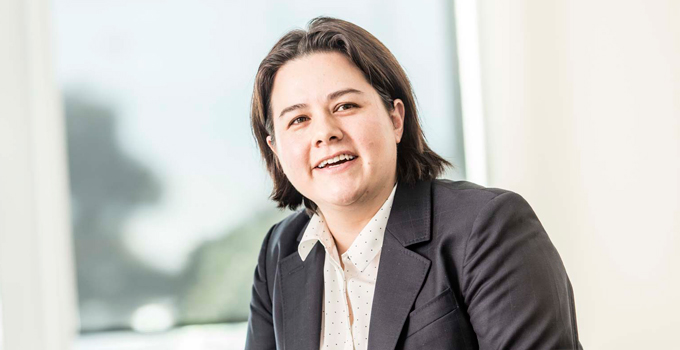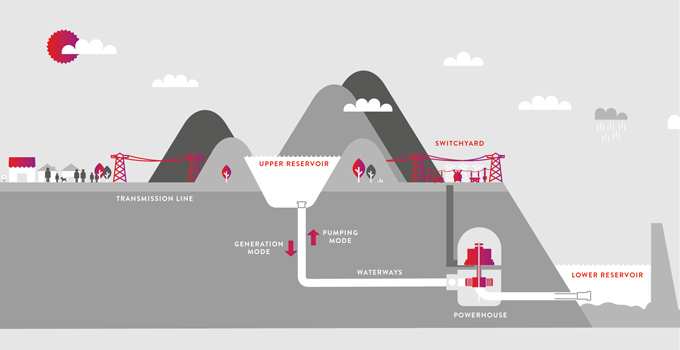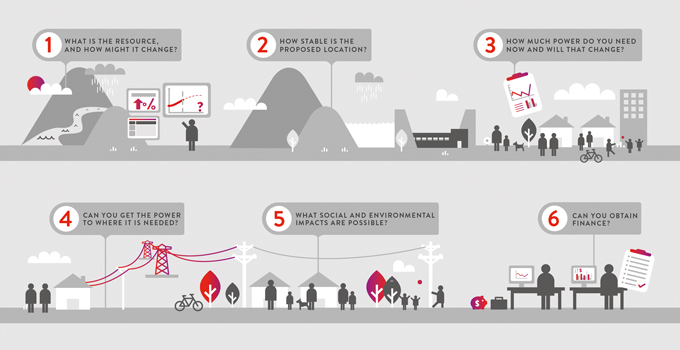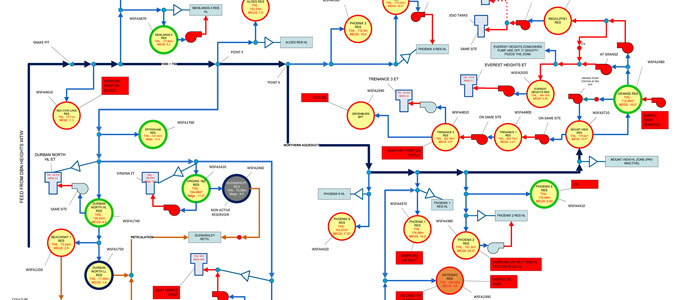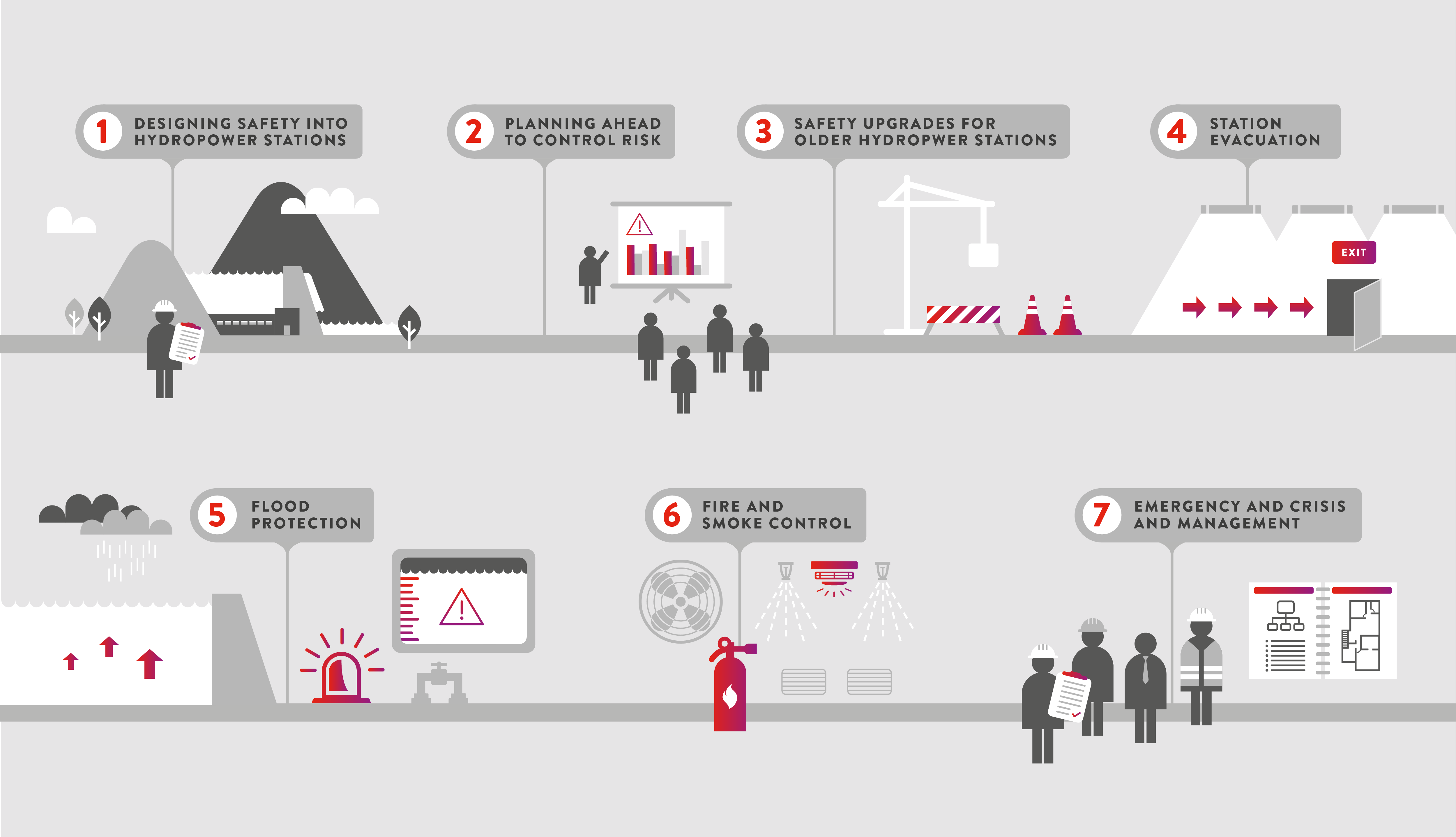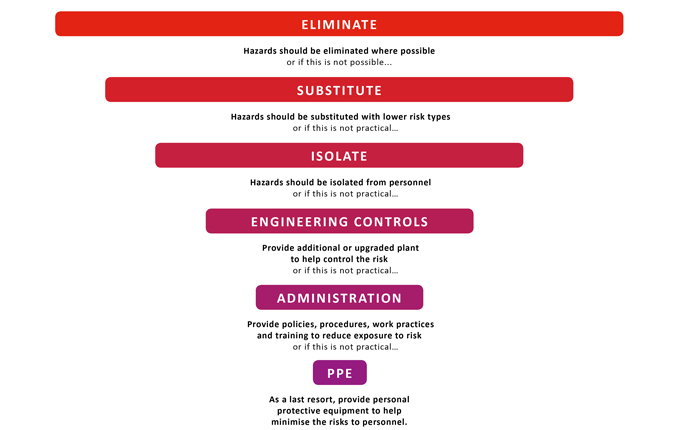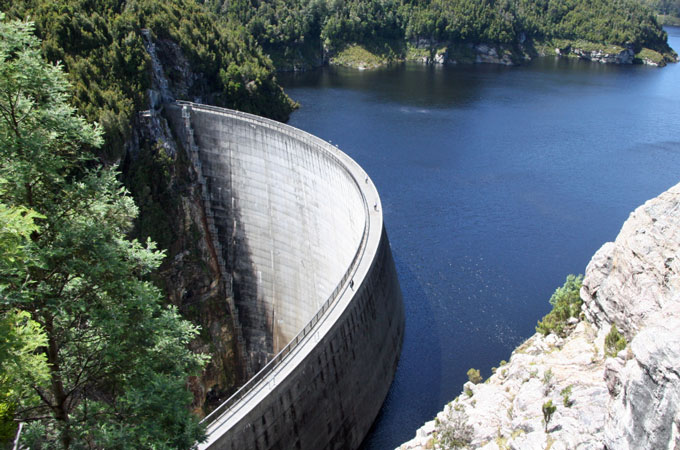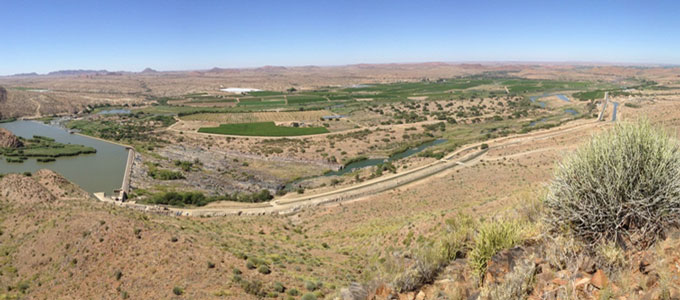Batteries vs pumped hydro – a place for both?
Two very different storage technologies – one old, one new; one that takes years to build, one that can be built ‘within 100 days (or it’s free)’. How else do they differ, and is there a place for both?
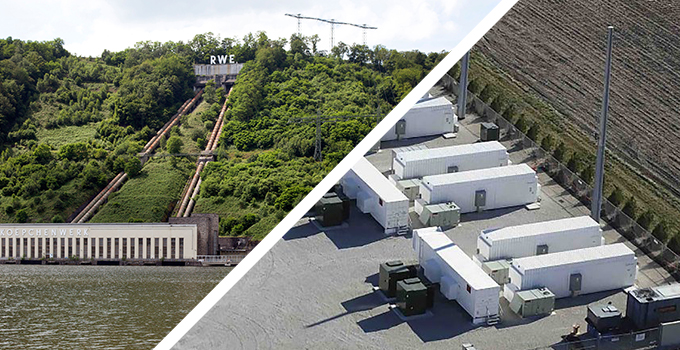
The rapid growth of renewable energy generation has been driven by two concurrent factors: the falling levelised cost of the energy produced by wind and solar, and the retirement of a number of coal-fired power stations. The recently released Finkel Review notes that by 2035, approximately 68 per cent of the current fleet of Australian coal generating plants will have reached 50 years of age.
The Clean Energy Target proposed by Dr Finkel is not yet confirmed but it recommends incentives for technologies with low or zero carbon emissions. More renewable energy generation brings new challenges in an increasingly complex grid. Dr Finkel therefore also proposes that energy storage be mandated for solar and wind farms.
Renewables can’t, on their own, meet the fluctuations in demand that occur throughout the day without some regulation as to when power reaches the grid. Power needs to be dispatchable. Dispatchable means that energy can be provided upon request. If the sun is not shining or the wind is not blowing, renewable energy cannot be dispatched unless it has been stored in some way.
There are a number of different types of storage but the two being discussed most widely right now are batteries and pumped hydro energy storage. These two technologies are very different and there are some limitations involved in comparing a well-known and established technology with one that is new and developing rapidly.
How do they support the network?
Pumped hydro is based on well-established synchronous generation, providing critical ancillary services to the grid, through the provision of inertia, frequency and voltage support and sufficient fault level support.
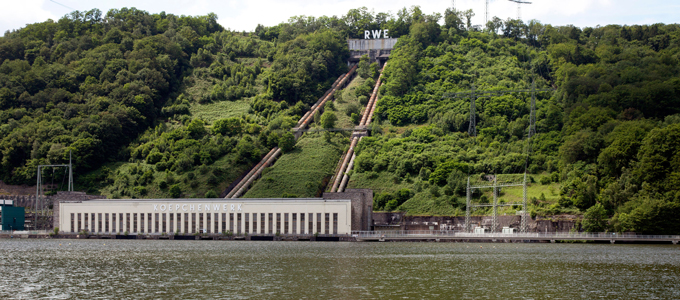
Battery inverter technologies are still catching up on most of these fronts. The potential for batteries to provide ‘synthetic inertia’ or fast frequency response is high but this is balanced by their reliance on system strength to be able to deliver this support. They offer minimal support with fault levels but can still provide some support to system frequency and voltage regulation.
How fast can they happen?
There’s no doubt that battery storage is quicker to implement than pumped hydro. South Australia has provided an example of just how quickly battery storage can be deployed.
In March 2017, the South Australian Government called for expressions of interest for the supply of grid-connected battery storage to be connected by the end of 2017. The overwhelming response from 90 interested parties tells us that this speed of deployment is within the realms of possibility.
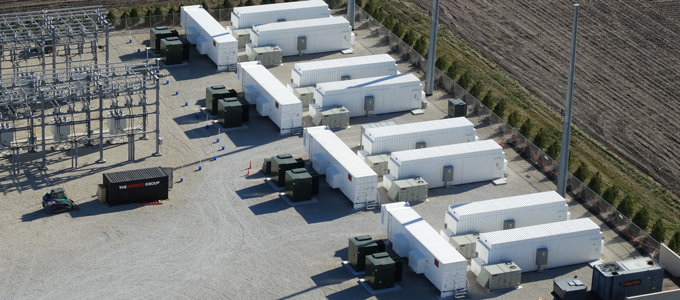
Battery image courtesy of Greensmith, a Wärtsilä Energy Solutions company.
Pumped hydro, by comparison, is a technology that takes much longer to implement. Typically, development activities (including optimising the technical solution, environmental and social assessments, arranging finance and finalising design) take two years or more to complete, and construction takes another two to three years.
How do the capital costs compare?
Pumped hydro boasts a very low price per megawatt hour, ranging from about $200/MWh to $260/MWh. Currently, battery costs range from $350/MWh to nearly $1000/MWh, with this cost reducing rapidly (costs reduced by about 25% during 2016).
According to the Lazard’s Levelized Cost Of Storage report, capital costs for pumped storage projects around the world range from about $1.5 million to $2.5 million per MW installed. The report also reveals that the cost of installing a grid-scale battery solution ranges from about $3.5 million to $7.5 million. This wide range of pricing for batteries is typical of a developing technology that is implemented in a variety of applications.
Ultimately, it’s difficult to predict how low the cost of batteries may go, but reports predict costs of lithium-ion batteries at somewhere around $120/MWh by 2025.
Considering that batteries need to be replaced once or twice a decade, with the currently available technologies, a battery facility will need to be replaced a number of times during the potential 100-year life of a pumped storage project. For batteries, assuming an economic life of 40 years, the initial cost plus replacements may mean whole-of-life costs fall in the range of $200/MWh to $330/MWh.
So, what does the future hold?
The rise of renewables will inevitably lead to a diversity of storage and supply solutions. The range of these solutions will depend on the resources of particular regions and locations. It is highly likely that the future for both batteries and pumped storage technologies will be extremely bright.
Batteries are here to stay and will undoubtedly play a significant role in future power systems as the technology develops and costs fall. However, while batteries can provide fast response times, they are yet to demonstrate their ability to provide the full range of ancillary services needed to support the grid. Pumped hydro remains a landmark, proven and reliable technology, able to meet the needs of the grid and provide sustained output for up to a century.
Ultimately, there is room for both batteries and pumped storage hydro, and they may even complement each other. Batteries are more cost-effective at delivering small amounts of stored energy over a short time at high power levels. Pumped storage is more cost-effective at storing and releasing larger amounts of stored energy. Achieving the optimum storage solution will depend on careful planning and finding the best fit for the particular circumstances.
What is certain is that both technologies will play important roles in the development and expansion of a network powered by renewable energy.
If you would like to discuss how Entura can help you with your next utility-scale battery or pumped hydro project, please contact Donald Vaughan on +61 3 6245 4279 or Nick West on +61 408 952 315.
A version of this article was first published in RenewEconomy.
About the authors
Donald Vaughan is Entura’s Technical Director, Power. He has more than 25 years of experience providing advice on regulatory and technical requirements for generators, substations and transmission systems. Donald specialises in the performance of power systems. His experience with generating units, governors and excitation systems provides a helpful perspective on how the physical electrical network behaves and how it can support the transition to a high renewables environment.
Nick West is a civil engineer at Entura with 16 years of experience, primarily in hydraulics and hydropower. Nick’s skills range from the technical analysis of the layout of hydropower projects to the preparation of contractual project documents and computational hydraulic modelling. Nick was a key team member of the Kidston Pumped Storage Project Technical Feasibility Study.
MORE THOUGHT LEADERSHIP ARTICLES
Shifting directions for hydropower in Asia-Pacific
The issues and trends we’re seeing playing out right now relating to hydropower and the clean energy sector are not unique to our region.
Having recently returned from a meeting of the Board of the International Hydropower Association, I’ve been reflecting on the challenges and opportunities facing the global hydropower sector.
It seems that there’s a global shift occurring in hydropower. Traditionally, hydropower has been viewed as a stand-alone, established renewable technology. Now we’re seeing a much greater sense of integration with other renewable technologies as part of broader ‘clean energy’ systems. With the rapid global increase of wind and solar power developments, hydropower needs to review its place, and its opportunities, within the wider energy sector.
Wind and solar tend to have shorter construction and implementation periods than hydropower projects. When the wind is blowing and the sun is shining, the power flows. But, as we know, the intermittency of these sources of power creates the need for some sort of storage to firm up the system.
Hydropower has traditionally provided both baseload and peaking capacity, but now we also have the opportunity to provide much-needed storage and the firming capacity urgently required to help stabilise grids as they integrate increasing levels of intermittent renewable technologies. Pumped storage hydropower may be particularly useful in this context.
In recent weeks the Australian federal government has expressed new interest in pumped storage options to help alleviate grid pressures, such as those experienced recently in South Australia. But it’s not only in Australia that we’re seeing increased discussion and enthusiasm about opportunities for pumped storage hydropower to integrate with other intermittent renewable technologies by offer firming power and assistance with stabilising the grid. It’s a global trend.
Also under discussion at a policy level in Australia right now is the energy ‘trilemma’ of security, equity (accessibility and affordability) and environmental sustainability. These three factors need to be in balance to ensure a secure power sector that meets the present and future needs of energy consumers while moving towards a lower carbon future. These three big issues that are so relevant right now in the Australian context are just as urgent in the global setting too, and need careful long-term planning, and the right mechanisms in place to support appropriate development.
It is interesting to review the World Energy Council Energy Trilemma Index, noting country rankings through the lens of hydropower and pumped storage integration. Not surprisingly, most countries ranked at the top of the list have been using these technologies for decades, which perhaps signals a direction for others to consider.
Another worldwide trend is the ongoing shift towards development of small to medium hydropower systems because many of the larger opportunities have already been exploited. For example, in China, many of the large hydropower schemes (10 000 MW, plus) have already been identified or developed, so new hydro developments are more likely to fall within the small to medium range, with the added advantage of shorter construction and implementation times. In Australia, smaller pumped hydro systems, or hydropower systems built into irrigation systems or water supplies, also have a significant role to play in the ongoing development of the hydropower sector.
Renewable energy and hydropower is a specialised field, so it’s critical that we also focus on the human resources and the capacity development needed to ensure a healthy future for the global hydropower sector. This is particularly so in regions which are new to hydropower and renewables, as the world shifts towards stronger support for renewables and replacing carbon-intensive power generation.
Hydropower is a mature, established technology, but that doesn’t mean we can’t be flexible and responsive to shifts in the global energy sector. As we strive towards the goal of affordable, reliable and sustainable power for all, hydropower has much yet to offer as a stabilising element of an integrated clean energy vision.
About the author
Tammy Chu is Entura’s Managing Director. She is responsible for Entura’s business strategy, performance and services to clients, and is part of Hydro Tasmania’s Leadership Group. Tammy joined the business in 2000 and has held a range of positions at Entura, from Technical Professional to Project Manager, Business Development Manager and Water and Environment Group Manager.
She has extensive managerial and business development experience in the consulting engineering industry within Australia and internationally, focusing on business strategy, change and transformation, international sales, culture, and profit and revenue growth.
As a civil engineer, Tammy specialised in the design and construction of mini-hydro and hydropower systems, project management, hydropower investigations, prefeasibility and feasibility studies, environmental assessments and approvals, resource investigations and resource water management.
Tammy is a member of the Board of the International Hydropower Association. She was the first female and now past president of the Tasmanian Division of Engineers Australia, and was an Engineers Australia National Congress representative.
Tammy holds a Master of Business and Administration from Chifley Business School, is a Fellow of Engineers Australia, and a graduate of the Australian Institute of Company Directors.
MORE THOUGHT LEADERSHIP ARTICLES
Overcoming the barriers to pumped storage hydropower
With energy reliability a hot topic in Australia, eyes are now turning to pumped storage hydropower… but what has been holding it back?
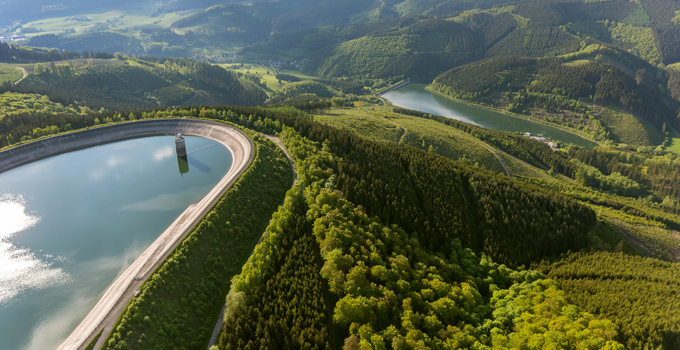
There are only three pumped storage hydropower projects in Australia, with the most recent completed more than thirty years ago. This is despite the ability of pumped storage hydropower projects to provide the large-scale storage that would complement increasing levels of renewable energy. Why is this, and what are the barriers to developing more Australian pumped storage hydropower projects?
Around the world, pumped storage hydropower projects make up the vast majority of grid energy storage and have traditionally been used by energy utilities to supply additional power to a grid during times of highest demand.
As part of a portfolio of power stations, a utility might operate a pumped storage project infrequently only, if the cost of pumping the water back to the upper storage exceeds the revenue that can be generated from its release.
The main issue facing developers trying to prove the viability of a new pumped storage project is that a sufficient price differential is required to pay for the pumping and to account for the efficiency losses in transmission, pumping and generation. The generation price needs to be sufficiently higher than the pumping price just to repay the variable pumping costs. To repay the heavy capital investment, a margin is required over and above the break-even cost of pumping. This is particularly true where proposed developments are ‘stand-alone’ and cannot be optimised as part of a corporate generation portfolio.
In recent years, electricity price spikes have been irregular with few occurrences each year. Due to the significant capital costs, a pumped storage scheme would require a certain number of pumping/generation cycles at high or maximum pricing to pay a return on investment. These price spikes are unpredictable, so building a business case around these events is risky.
Historically, the daily fluctuation of power prices has not been sufficient or regular enough to attract pumped storage developers. This is beginning to change with increasing penetration of renewable energy leading to an increase in both low and high price periods. More frequent, sustained periods of hot weather (as predicted by climate change models) will also drive up demand for power and therefore the market price.
In the last few months, volatility has greatly increased, creating a greater differential between baseload and peak pricing. This will increase the viability of pumped storage schemes, although the unpredictability and challenges of financing capital intensive assets will remain.
But, even when the economics are right, there are still some other barriers that proponents of pumped storage projects need to overcome:
Finding the right site
Pumped storage projects require significant capital for development. Minimising the cost of construction and operation is key to the successful development of a project. Choosing the right location is a matter of identifying a site with ideal topography, a source of water and good proximity to and location within the transmission network.
A wealth of information is available that is relevant to identifying potential pumped storage hydropower sites. Concept studies for pumped storage hydropower sites can screen potential sites quickly and offer developers greater insight into possible opportunities.
Negotiating access to appropriate sites for pumped storage
While a pumped storage project generally has a significantly smaller footprint than a traditional hydropower project, the features of natural topography that are ideal for pumped storage – high, steep hillsides or cliffs – tend also to be places of great natural beauty and are often designated as reserves, are expensive private land, or have high environmental or social value.
State governments can assist here through streamlined planning and approvals processes for infrastructure developments. This can make sure that the challenges of developing sites do not become insurmountable for developers.
Perceived environmental impacts
Pumped storage projects can occupy many square kilometres and also require transmission lines to connect to the electricity market. Like traditional hydropower projects, pumped storage projects need to attend to environmental issues associated with the project. Environmental impacts for pumped storage projects are assessed in the same manner as for all infrastructure developments.
If the impacts of a project can be mitigated to the satisfaction of the relevant regulatory body and international Standards (such as the International Hydropower Association and International Finance Corporation), a pumped storage hydropower project should face no greater hurdle than any other infrastructure project in this respect.
A pumped storage project may also have to deal with the perception that it uses carbon-intensive thermal power to pump water during the pumping cycle. This may be true unless there is a surplus of renewable energy available, in which case the pumped storage project could be seen to be using this excess renewable energy for pumping. As renewable energy penetration grows, the opportunities for storing surplus renewable energy will increase.
An unfavourable regulatory framework
Inconsistent and uncertain policy positions of the major political parties at both federal and state levels reduce confidence in the energy industry, which deters investment. With debate raging over energy security, a bipartisan view on energy policy, which transcends party politics and the electoral cycle, is urgently needed.
Existing mechanisms are in place to support the renewable energy industry. The Renewable Energy Target (RET) promotes investment in renewable energy projects; however, pumped storage is specifically excluded from the RET where the energy used for pumping exceeds the energy generated. Current policy would have to be amended or complementary legislation enacted in order to reward large-scale storage for the service it provides.
Such changes could include market mechanisms for large-scale storage that could offer incentives for providing inertia and ancillary services from storage at times of peak demand as well as power. Another possible change could be to ensure that large-scale storage asset owners are not penalised under the RET for energy used in the pumping process. This would encourage the development of energy storage as a complement to the growth of renewable energy.
High cost of development activities
The long lead times and high development costs of pumped storage projects are major deterrents to developers. Projects generally take more than 4 to 5 years from the point of conception to ‘power on’, and require millions of dollars of capital for development and hundreds of millions for construction. In other words, when funding is first committed, it may not see a return for five years or more.
In an effort to overcome this barrier, the Australian Renewable Energy Agency (ARENA) has indicated it will allocate at least $20 million to finance the accelerated development of flexible capacity and large-scale storage projects. The Clean Energy Finance Corporation (CEFC) has also committed to provide successful ARENA funding recipients with the opportunity to secure long-term debt finance to support their projects.
With an increasing interest and emphasis on storage in a power system that is becoming increasingly unreliable (e.g. load shedding in South Australia and lack of reserve events in New South Wales), and with finance from ARENA and CEFC for large-scale storage, the barriers to pumped storage development are gradually diminishing. This action can’t come soon enough for residents suffering through blackouts on days over 40°C.
If you would like to discuss how Entura can help you overcome the barriers for a pumped storage hydropower project, please contact Patrick Pease, Nick West on +61 408 952 315, or Richard Herweynen on +61 3 6245 4130.
A version of this article has been previously published as an op-ed in the Adelaide Advertiser.
About the authors
Nick West is a civil engineer at Entura with 16 years of experience, primarily in hydraulics and hydropower. Nick’s skills range from the technical analysis of the layout of hydropower projects to the preparation of contractual project documents and computational hydraulic modelling. Nick was a key team member of the Kidston Pumped Storage Project Technical Feasibility Study and was involved throughout the development and construction of the Neusberg Hydroelectric Project in South Africa. Nick has successfully completed projects ranging from hydraulic design for small residential developments to the feasibility study of a cascade of four large hydroelectric projects in Malaysia.
Richard Herweynen is Entura’s Technical Director, Water. Richard has three decades of experience in dam and hydropower engineering, and has worked throughout the Indo-Pacific region on both dam and hydropower projects, covering all aspects including investigations, feasibility studies, detailed design, construction liaison, operation and maintenance and risk assessment for both new and existing projects. Richard has been part of a number of recent expert review panels for major water projects. He participated in the ANCOLD working group for concrete gravity dams and is the Chairman of the ICOLD technical committee on engineering activities in the planning process for water resources projects. Richard has won many engineering excellence and innovation awards (including Engineers Australia’s Professional Engineer of the Year 2012 – Tasmanian Division), and has published more than 30 technical papers on dam engineering.
MORE THOUGHT LEADERSHIP ARTICLES
Is pumped storage hydro the key to increasing renewables in Australia?
Recent electricity price spikes and a state-wide blackout in South Australia have highlighted the need for reliable power to balance the potential volatility of some renewable power sources.
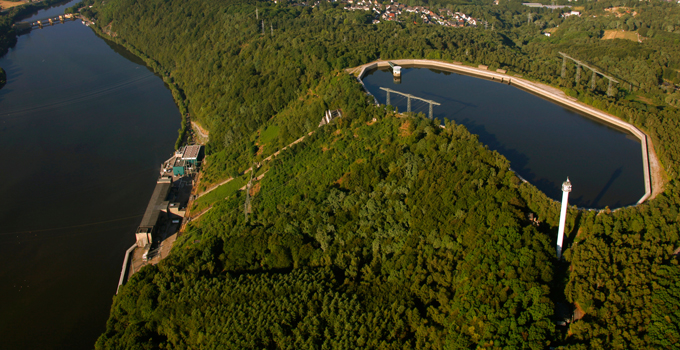
Pumped storage hydropower projects are a natural fit in an energy market with high penetration of renewable energy as they help to maximise the use of the renewables that are subject to the vagaries of the weather. Pumped storage provides a load when the wind is blowing and the sun is shining, and it also provides a reliable and immediate source of energy when the sun has set and the wind has dropped.
The recent completion of the feasibility study for Genex Power’s Kidston Pumped Storage Hydro Project in North Queensland shows this approach is now technically and commercially feasible.
Pumped storage hydro offers utility-scale storage and system stability
As the proportion of renewable energy in an energy market increases, the need grows for the stability and consistency provided by utility-scale energy storage. For example, South Australia needs system-wide storage of 500 MW for a period of 10 hours to improve the flexibility of wind farm operators, according to the Melbourne Energy Institute.
At the smaller scale of energy storage, the buzz about various types of batteries continues – but the only storage option with a proven track record at the utility scale is pumped storage hydropower.
Pumped storage hydropower works by pumping the water stored in a lower reservoir into a more elevated reservoir. The water stored at height can be passed through a turbine on its path back to the lower reservoir, creating electricity as and when needed, and making the best use of the water resource without waste.
In a recent article, my colleague Donald Vaughan stated that a functioning AC power system needs inertia, fault level, frequency and voltage control as well as energy sources to function to an acceptable standard. Pumped-storage assets can provide all of these important contributions to a stable and successful power system, levelling out the fluctuations in availability of wind and solar energy, and helping to regulate voltage and frequency.
New opportunities for pumped storage hydro in Australia
Despite the significant potential and benefits of pumped storage hydro projects, only three projects currently exist in Australia (two in New South Wales and one in Queensland). These schemes were built in markets in which generation was mainly thermal, where the pumped storage could supplement supply at times of peak demand.
A number of possible sites have been identified for new opportunities for pumped storage hydro, but so far very few have been developed beyond concept level. This means that opportunities exist for developers in states such as South Australia and Queensland that have set ambitious renewables targets and must maintain energy security.
Three factors for pumped storage hydro success
For successful pumped storage hydro projects, developers need to identify a viable site, achieve a technically and commercially feasible design, and make the most of the economics of the energy market.
1 – Identifying a viable site
For a pumped storage project, what’s needed is a source of water, and two reservoirs separated by a significant change in elevation. The water could come from a nearby river, an existing reservoir, or the sea. With many thousands of potential sites across the country, a developer needs smart methods of filtering to reduce the many possibilities to just a few ideal sites.
An important consideration is the effect on the viability of pumped storage projects of the relative remoteness of sites, through both the efficiency of the power’s round trip and the marginal loss factors (factors applied to a generator or a load, and calculated based on the size and distance of the generator or load from a central point).
As for any development, the process of identifying sites must also consider topography, land use and environmental constraints. Pumped storage projects generally present similar but reduced environmental risks as conventional hydropower projects as they tend to have smaller footprints.
2 – Achieving a technically and commercially feasible design
Entura’s experience on Genex Power’s Kidston pumped storage hydro project has shown that it is possible to construct low-cost pumped storage projects in Australia through careful site identification and clever project design. Where a pair of suitable reservoirs don’t already exist, constructing a turkey’s nest dam may offer a solution.
A turkey’s nest dam is a reservoir built by excavating earth from the centre of the reservoir and moving it to the edge to help form a continuous embankment. Turkey’s nest dams have been used successfully around the world in pumped storage hydropower projects, providing opportunities to build projects where elevation changes significantly over a short distance.
Additionally, turkey’s nest dams can help to minimise capital costs by reducing conduit lengths and maximising head (the difference in elevation between the upper and lower reservoirs).
3 – Making the most of the economics of the energy market
Understanding the opportunities and constraints in the energy market is critical to a pumped storage project’s financial viability.
When you can store energy, you can dispatch electricity at peak times, gaining the highest price point in the market. Conversely, water is pumped to the upper reservoir in off-peak periods or when supply from renewable sources is high and market prices are low. This ‘energy arbitrage’ makes the most of the price difference in the electricity market.
Selecting the optimum installed capacity of a pumped storage project also requires detailed understanding of energy markets. It is possible that a pumped storage project can act to flatten peak prices to the point where the returns on a project are insufficient to meet financiers’ hurdles, so detailed revenue modelling is essential to determine the tipping point between enough and too much installed capacity.
With careful selection of sites, clever design, and the right mix of capacity and costs, pumped storage hydro holds an important key to unlocking the full potential of renewables in Australia’s electricity market.
If you would like to discuss how Entura can help you explore potential opportunities for pumped storage hydropower projects, please contact Nick West on +61 408 952 315 or Richard Herweynen on +61 3 6245 4130.
About the author
Nick West is a civil engineer at Entura with 15 years’ experience, primarily in hydraulics and hydropower. Nick’s skills range from the technical analysis of the layout of hydropower projects to the preparation of contractual project documents and computational hydraulic modelling. Nick was a key team member of the Kidston Pumped Storage Project Technical Feasibility Study and was involved throughout the recently completed Neusberg Hydroelectric Project in South Africa. Nick has successfully completed projects ranging from hydraulic design for small residential developments to the feasibility study of a cascade of four large hydroelectric projects in Malaysia.
MORE THOUGHT LEADERSHIP ARTICLES
Five steps to better understanding geological risks in hydropower projects
Not fully understanding the geological conditions is one of the biggest risks in a hydropower project, and can lead to large cost blow-outs, major repairs and even public safety issues.

Understanding the geological conditions enables engineers to design safe and stable structures, and to minimise project and financial risk. The geological risks don’t stop at the dam site, but also extend to the spillway, powerhouse, tunnels and other structures.
Hydropower developers often ask: ‘how much should I spend on geological investigations for my hydropower project?’ and ‘how many drill holes do you normally need for a dam site?’
The answer depends on what is already known and what risks have been identified through the available regional geology and the geological mapping of the site. Geological investigations aim to understand the risks at the site by progressively developing a geological model.
Five steps to achieving a good geological model
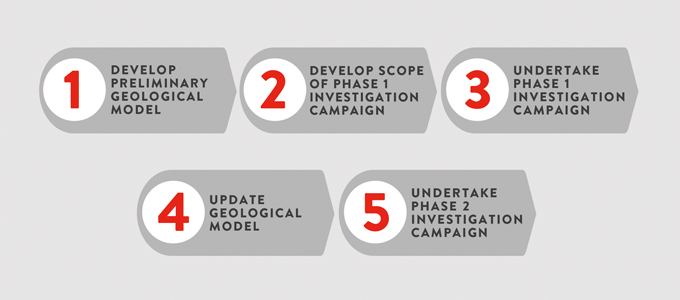
It is important to have a clear, systematic process to achieve a good geological model and, therefore, ensure that the subsurface geological risks are well defined.
Entura has developed and adopted the following five-step process:
Step 1 – Develop preliminary geological model
The first step is to develop a preliminary geological model of the site based on available geological information, aerial photos, topographic data and geological surface mapping. Spending the necessary time to source and collate all the available information is valuable.
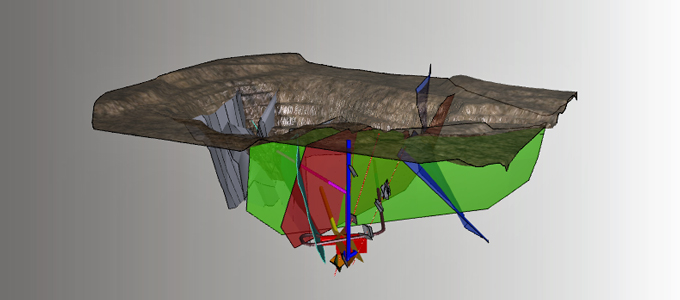
The model should include not only the geological units but also the main defects such as bedding, joints, shears and faults. Understanding the main defects helps to determine whether there are any potential failure mechanisms within the foundations underlying the project structures.
Step 2 – Develop scope of phase 1 investigation campaign
Based on this preliminary geological model, we can determine what needs to be confirmed or known, and then plan the phase 1 investigation campaign. The investigations must relate strongly to what you are trying to confirm or determine with the geological model. Without this strong relationship, the developer may be wasting money.
The investigation techniques planned depend on many factors including known geological conditions, information gaps, environmental constraints, site access, available skills and equipment, time and cost. There should be a clear objective for every test pit excavated, geological hole drilled, geophysical survey performed and laboratory test undertaken.
The outcome of Step 2 is the scope of works for the phase 1 investigation campaign. The development of the scope of works is a task in itself and should be performed by a suitably qualified engineering geologist. The preparation of a scope of works ensures that the developer can call for quotations from prospective consultants and contractors with confidence that the campaign will be targeted at improving the understanding of the identified geological risks.
Step 3 – Undertake phase 1 investigation campaign
The third step in developing a good geological model is to undertake the phase 1 investigation campaign.
The investigation campaign should be supervised by an appropriately qualified engineering geologist who is empowered to direct the investigations contractor and who has the flexibility to adjust the investigations as necessary based on the site observations.
For example, the core is not the only result of a drilling excavation: drilling rates, water loss, the colour of drill cuttings, hole collapse and groundwater levels all provide important information that is not visible in a core tray.
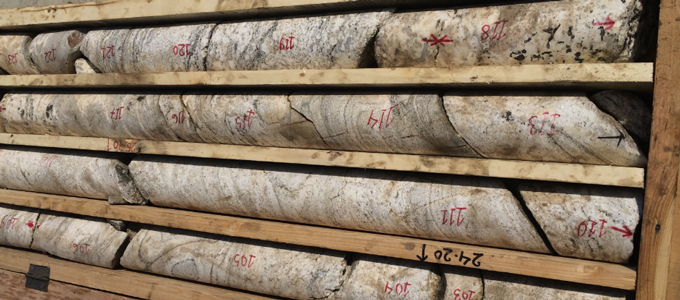
Local contractors are commonly engaged for geological investigations due to the need for heavy excavators and drill rigs. The contractors must be experienced with well-maintained equipment that is appropriate for the task (hole size, hole depths and geological conditions). Appropriate drilling techniques are required to maximise core recovery in the areas of interest, even if they take some time.
Developers must not underestimate the challenges of site access. A significant amount of time can be lost repairing broken plant in remote locations, so the proposed plant should be inspected and tested before site mobilisation.
Laboratory testing should only be performed at reputable laboratories, otherwise there is a risk of destroying samples and wasting time and money for little benefit. Typically, we use local laboratories for common tests, such as those used for concrete manufacture or road construction, and we may use specialised laboratories for more complex or unusual testing.
The outcome of Step 3 in our five-step process is significantly more factual geological and geotechnical information.
Step 4 – Update geological model
Step 4 is to interpret this additional factual information, and to update the preliminary geological model (developed in Step 1). This will improve understanding of the geological risks at the site, which is the key return on the investment made in the investigation program.
Step 5 – Undertake phase 2 investigation campaign
Step 5, the final step in the process, is a phase 2 investigation campaign. It is very common for hydropower projects to undertake more than one geological investigation campaign. This is because the geological model may change due to the information discovered in the first campaign, which may raise further questions or unknowns.
The second campaign, if required, is likely to be very focused, as it will be addressing a specific question, and will help to finalise the geological model.
Asking the right questions
Rather than asking how many holes are normally drilled for a dam project or how much money is normally spent on geological investigations, hydropower developers should ask: ‘is the money being spent wisely and for a clear purpose?’
Geological investigations do not reduce geological risks; they merely improve the understanding of the risks. A good understanding of the geological conditions reduces the uncertainty of capital cost, and therefore enables developers to make well-informed and less risky investment decisions.
To discuss how Entura can assist you to better understand the geological risks to your hydropower project, please contact Shekhar Prince on +61 412 402 110 or Richard Herweynen on +61 3 6245 4130.
About the author
Richard Herweynen is Entura’s Technical Director, Water. Richard has three decades of experience in dam and hydropower engineering, and has worked throughout the Indo-Pacific region on both dam and hydropower projects, covering all aspects including investigations, feasibility studies, detailed design, construction liaison, operation and maintenance and risk assessment for both new and existing projects. Richard has been part of a number of recent expert review panels for major water projects. He participated in the ANCOLD working group for concrete gravity dams and is the Chairman of the ICOLD technical committee on engineering activities in the planning process for water resources projects. Richard has won many engineering excellence and innovation awards (including Engineers Australia’s Professional Engineer of the Year 2012 – Tasmanian Division), and has published more than 30 technical papers on dam engineering.
MORE THOUGHT LEADERSHIP ARTICLES
Hydropower generates opportunities for businesses in India
In recent years, India has emerged as a world leader in renewable energy and this growth is presenting opportunities for businesses looking to diversify their activities.
A range of renewable energy developments such as wind and solar, from the smallest to the largest scale, are planned and getting underway all around India. There’s also still plenty of untapped potential for hydropower, particularly in the rugged north and north-west of the country.
Estimates suggest that less than a third of the country’s potential for hydropower has so far been exploited – and that presents an opportunity for organisations seeking to embrace renewable developments as part of their commitment to sustainable social and industrial development, quality of life, and a clean energy future for the nation.
The time is ripe for private investment in hydropower in India. Significant government incentives and subsidies are available to encourage increased hydropower development. Hydropower also offers added value to the power network in the form of immediately dispatchable power to balance any variability of solar and wind output.
Enthusiasm and opportunities are two important factors leading to hydropower success, but another critical factor is reliable expertise, and this may be less available to many potential proponents of hydropower projects if they are new to the hydropower sector.
Progressing through all the necessary steps of any power development process is difficult at the best of times, let alone for a developer who has little or no prior experience.
Hydropower, like all power developments, has its challenges: land acquisition, resettlement, rehabilitation, geology, technical challenges in dam and scheme design and construction, financing, and so on. These challenges can be considerable, but can also be overcome with the right expertise on hand.
Chanju-I hydropower project: a success story
When Indo Arya, a large conglomerate with interests in steel, thermal power and logistics, decided to make its first foray into hydropower, it recognised the need to engage an experienced hydropower consultant and it turned to Entura to provide the long-term support to ensure the hydropower project’s success, from the earliest feasibility study right through to operation.
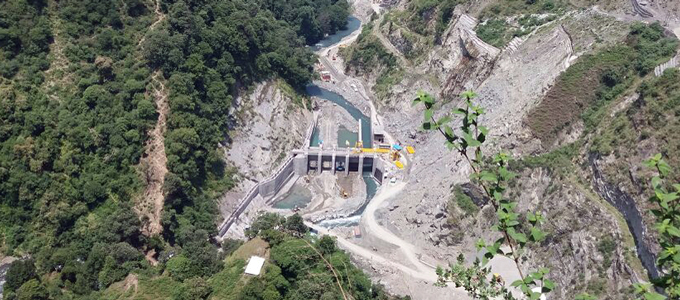
I A Energy, a special purpose vehicle, was formed for implementation of the Chanju-I run-of-river hydropower project in the Indian province of Himachal Pradesh. I A Energy provided all the financial and management capabilities, while Entura provided the technical expertise and project development knowledge.
Entura’s ongoing role in this project, supporting the client across all project stages as a trusted advisor, went beyond what might be described as ‘owner’s engineer’, achieving a considerable level of collaboration between developer and consultant that enabled the project’s success.
Now, nine years since the earliest site visits, the Chanju-I run-of-river hydropower project is set to deliver its 36 MW of renewable electricity, thanks to the power of the water flowing downstream from the confluence of the Bhararu and Chanju rivers. The project will generate attractive financial returns for its owner and the State Government, but will also directly benefit the local community, with power, tuition and health services.

Entura’s involvement over the full cycle of the project helped I A Energy ensure the right location, access and water availability for a viable project. We recommended the site, and then worked closely with the client to progress the project through its various stages, including site investigations, exploration of hydropower potential, environmental impact assessment, feasibility assessment, project approval, tender design, detailed design and construction advice and support.
Entura also assisted I A Energy to set up the organisation of the project and quality procedures on site, and our engineers regularly attended the site to provide ongoing advice and support during construction.
The project involved constructing a 16m-high barrage, a 5km-long headrace tunnel, two underground desilting chambers, pressure shafts, and a surface powerhouse. Entura provided technical expertise in optimising the design and construction, costing, contract packaging, selection of equipment, scheduling and project management. Our involvement delivered valuable outcomes such as increasing the asset capacity from 25 MW to 36 MW.
Overcoming project challenges
During the development phase, the Chanju-I project faced many issues and challenges with the potential to stop or significantly delay the project. These issues included approval delays, environmental issues, stakeholder management, and disagreements with upstream developers with respect to the location and height of the barrage, river basin development plans and infrastructural development.
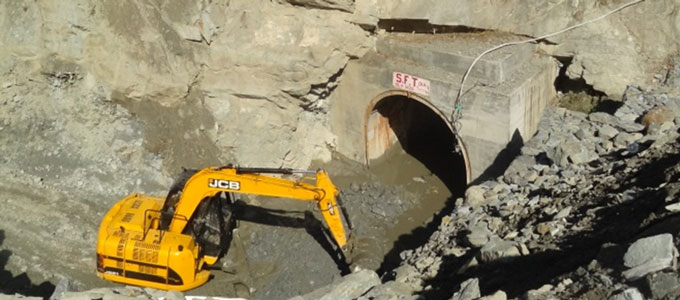
Entura’s continuous involvement, timely advice and support during critical situations helped the project team stay on top of these challenges, ensuring ultimate project success. In spite of the hurdles, the collaborative approach provided an efficient mechanism to address the issues and move the project forward at all times, even enabling early commencement of construction. By fast-tracking the construction of the project, the developer maximised its returns, and the project has been noted for its speed and efficiency in construction.
The way Entura serviced the project was praised by the project authority and strengthened our relationship with I A Energy. The longevity of Entura’s engagement with I A Energy on the Chanju-I project demonstrates the importance we place on delivering well for our clients, whether the project is small or large, and our ability to work as a valued and reliable partner of the client throughout the full project lifecycle.
To find out more about making the most of the opportunities available in the global renewable energy sector, please contact Shekhar Prince on +61 412 402 110.
MORE THOUGHT LEADERSHIP ARTICLES
Getting hydropower right: The six key considerations for a successful project
So, you want to develop a hydropower project? Any hydropower development is a major undertaking, so you need to be sure you get it right.
In our increasingly electricity-dependent world, hydropower offers a cost-effective and environmentally sustainable, clean-energy solution with significant development opportunities in Asia and Africa particularly.
Solving the technical challenges to establish a reliable hydropower scheme may seem complex, but engineering issues are only one part of the equation and may even be relatively straightforward compared with some of the broader issues and risks affecting a project’s success or failure.
Hydropower developments are more likely to gain social and regulatory approval, adequate and secure finance, and be successful in the short and longer term, if you pay early and detailed attention to the following six key considerations.
1 – What is the resource and how might it change?
Properly investigating the long-term history and variability of an area’s water resource is essential to the success of any hydropower project. However, even in areas in which water availability may have been reasonably consistent in the past, climate change introduces a new level of uncertainty for future projections.
To maximise the success of a new hydropower development for the short term as well as long into the future, it is essential to build climate resilience into projects. This requires specialist hydrological modelling based on the best historical data combined with expert future projections, taking into account the range of potential impacts on climate, rainfall, inflows and water availability.
Climate effects may not always mean reduced water availability. In some cases, the hydropower scheme may need to be able to accommodate and optimise the use of increased rainfall or inflow.
However uncertain the future resource, thorough investigation of what is currently known and what can reasonably be projected gives you the best chance of a successful, climate-proof scheme that can withstand future inflow variability and other longer term changes in the catchment.
2 – How stable is the proposed location?
One of the greatest potential complications and causes of delay in a hydropower development project is an unwelcome geological surprise.
Thorough, specialised investigation of the proposed site’s topology, geology and seismic risk is crucial, and can greatly impact cost, financing and viability. The more stringent and detailed the preliminary geological and geotechnical investigations, the more likely you are to avoid problems through the construction period and deterioration of the infrastructure over time.
This is particularly important where a large dam is proposed, as the extra weight of the water, concrete and sedimentation creates massive forces on the dam’s foundation, which may cover a large area and a potentially geologically diverse set of subsurface conditions. The choice of the appropriate dam type and construction method must be influenced by the unique conditions of the dam site, and stability of the site is a key consideration.
3 – How much power do you need now and will that change?
Populations and their demands for power don’t stay static for long. It’s important to think about the broader demographic of the region in which your scheme is to be developed. Is the population growing rapidly due to an ongoing rising birthrate, or could it shift significantly due to changes in neighbouring regions creating population movement?
Furthermore, industrial demand needs to be carefully projected, especially in a growing economy. What is the future development potential of local towns or cities? Is there potential for any major new industry in the region that may rapidly increase the power demand? On the other hand, are there any foreseeable threats to existing major industries that may suddenly lower demand?
As technology and lifestyle expectations change, especially in developing nations, residential demand may also rise rapidly. This demand can also be significantly, although usually predictably, variable, such as where climate extremes create peak demand coinciding with heating or air-conditioning requirements.
Another important factor, particularly in Asia and parts of Africa, is the potential for power generated in one country to be sold to neighbouring countries.
4 – Can you get the power to where it is needed?
A power source is only useful when it can reach a potential user. So another key consideration for a successful hydropower development is the ability to deliver the power to where it is needed through existing, upgraded or new transmission and distribution infrastructure.
Commonly, the best economic outcome of a power development is when much of the load can be used near to where it is generated, as this lowers the costs of transmission development, and lessens the loss of power when it is transferred over distance. Those few percentage points of power loss over distance could make the difference in the overall financial return on investment.
Careful planning of the routes for transmission and distribution lines is critical to success, with sizeable implications for project costs if lines must cross remote or rugged terrain, or socially or environmentally sensitive areas.
5 – What social and environmental impacts are possible?
From the earliest thoughts and discussions about a new hydropower development, it is critical to consider the project’s stakeholders, community and environment. As well as providing benefits to a project’s owner, electrification can deliver significant benefits to affected communities, raising living standards, alleviating poverty, helping to develop and diversify economic activities, as well as potentially improving water availability and management. However, hydropower should never be developed to the detriment of affected communities or the environment.
A ‘social licence to operate’ is fundamental to long-term success of your hydropower project. This can only be achieved where due consideration is given to social and environmental impacts throughout the project lifecycle, including those around changes in land use and ownership, and adequate consultation and engagement is undertaken with affected communities so that they receive a net benefit from the project.
Stakeholder engagement is the key to determining appropriate avoidance, mitigation, offsetting or compensation of any potential impacts – both immediate impacts, and impacts that may only emerge in the longer term. The most successful consultation is the ‘bottom-up’ and transparent approach, where affected communities are engaged and involved in the project right from its inception.
Safety is also a critical issue to be managed throughout a project’s life, including the safety of construction workers, ongoing employees, and the broader community. Identifying key safety risks early and managing them appropriately throughout design, construction and ongoing operation is critical to protecting a developer or owner against the major social and environmental consequences of a safety incident, as well as the long-term damage to that business’s reputation and financial viability.
6 – Can you obtain finance?
No hydropower project will succeed without available, secure project financing. Although hydropower developments offer opportunity to developers and financiers, lenders around the world are increasingly cautious and will require evidence of best-practice and sustainability to release project funds. They will need a range of risks to have been adequately investigated and mitigated, including all those considered above, as well as local political and regulatory issues.
A useful tool to evaluate the sustainability and strengths of a hydropower project and identify any further opportunities for risk mitigation is the Hydropower Sustainability Assessment Protocol.
Using a framework such as this offers investors greater confidence that their investment is safe, and that structured and systematic efforts have been undertaken to foresee risks across the spectrum of financial, technical, stakeholder, community and environmental issues.
Although not all risks can be avoided, this is the closest we can reasonably get to being confident that the project will not encounter any significant delays or problems through its lifecycle and will deliver the social, environmental and economic benefits it promises.
To discuss how Entura can help you plan and deliver a successful hydropower project, please contact Shekhar Prince on +61 412 402 110.
MORE THOUGHT LEADERSHIP ARTICLES
Managing risks for successful, sustainable projects
All power and water projects involve risks. The key to project success and sustainability is being able to anticipate, monitor and manage the full range of risks throughout the project lifecycle.
For power and water asset developers, sustainability is increasingly recognised as a key marker of project success and corporate reputation. Whether you’re building a hydropower station, a dam, a wind farm or a solar farm, achieving sustainability means ensuring that projects appropriately balance technical, environmental, social and economic considerations to deliver benefits and minimise risks across all these areas.
Power projects, especially in developing countries, hold great potential to contribute to the greater good by increasing prosperity and alleviating poverty, but growth must be balanced against any current and future impacts on communities or the environment. Sustainability is therefore a key concern for responsible developers, and for international financing organisations such as the Asian Development Bank, the International Finance Corporation and the World Bank.
Managing risks carefully, ethically and transparently can improve the financial and technical viability of the project, the ability to secure finance, the ability of key stakeholders to make informed decisions about the project’s future, the likelihood of community acceptance or ‘social licence to operate’, and the overall project outcomes, both now and for long-term success and sustainability.
What are the risks?
Some of the key risks to be considered throughout the design, development and operation of a power or water asset include factors such as the need or market for the project, the future energy or water demand, the best technology or design for the project, and the current and future availability of the resource.
It is also critical to consider the project’s stakeholders and broader community, particularly whether the project could involve potential social or environmental impacts and how these could be avoided, mitigated, offset or compensated, not just during development of the project but also during operation. Safety is also a key issue to be managed throughout a project’s life, including that of employees as well as the broader community.
Although not all risks will necessarily be able to be fully predicted, businesses are likely to gain substantial benefits from making structured and systematic efforts to foresee risks across the spectrum of financial, technical, stakeholder, community and environmental issues.
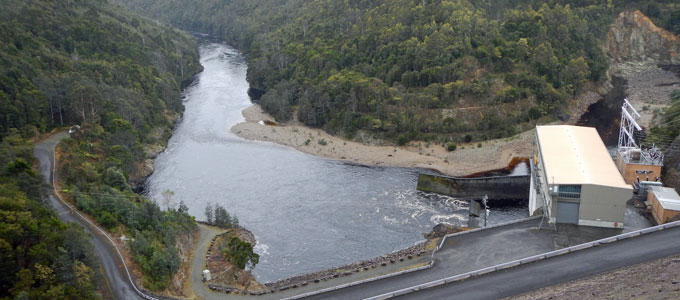
Assess risks early and often
Many project risks can be minimised or mitigated if they are properly anticipated early in the project, and progressively monitored and evaluated throughout the design, development, construction and operational phases.
Identifying key risks early allows companies to manage these risks throughout the project, minimising corporate, technical, environmental and social impacts and their associated costs, including damage to corporate reputation should an unmanaged risk develop into a crisis.
Assessing the risks progressively or in stages can minimise not only the cost of formal evaluation, but also save significant time and costs that could be wasted if a project were to be judged unviable during development.
Sustainability assessment, both formal and informal
Being able to formally or informally assess and comprehensively document risks and actions towards project sustainability offers significant advantages. While it can help guide a comprehensive review of risks, it can also help to identify further opportunities to increase positive outcomes. As well, it provides an easy way to regularly assess progress towards sustainability goals against established baselines, and offers a format for clear reporting both internally and to external funding bodies and stakeholders. In other words, sustainability assessment and reporting is a valuable step in demonstrating a genuine commitment and responsible approach to achieving greater sustainability.
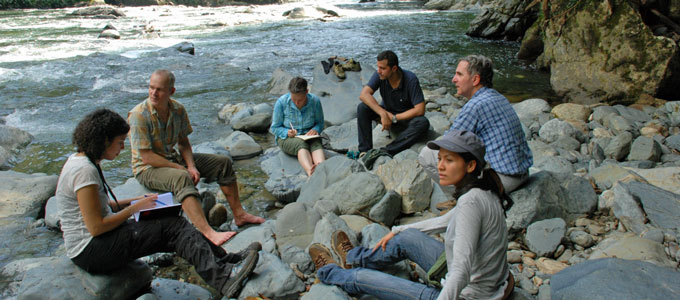
Entura uses a unique, tailored self-assessment tool to help power and water companies and developers understand the risks and opportunities facing their projects and build their capacity to assess, monitor and report on those projects. This tool is based on the assessment criteria identified in internationally recognised guidelines and standards such as the Hydropower Sustainability Assessment Protocol and those used by the International Finance Corporation.
The sustainability scanning tool can be used by an organisation to self-assess a project to identify whether key issues, risks and opportunities have been fully considered and to identify potential gaps needing further attention. This can be done internally following training on how to assess the criteria or undertaken by Entura’s trained assessors.
In addition, Entura’s sustainability scanning tool can be adapted to include other standards relevant to a project or client, or to assess compliance with criteria relevant to a client’s requirements or obligations (such as internal policies and/or permit or concession conditions). It can be used at any stage, or multiple stages, of a project, and for any level of sustainability goal (i.e. good practice or best practice). It can also be repeated over time for the same project to assess ongoing improvement, or to compare projects across a client’s portfolio.
The potential benefits to power and water asset developers of a systematic and thorough identification and management of the full range of project risks include easier access to finance, reduced corporate risks and costs, greater ability to anticipate and respond to stakeholder concerns, and avoidance of delays and problems through the project’s life.
This holds promise for delivering power and water infrastructure projects that are more likely to contribute positively to social, environmental and economic goals both now and into the future.
If you would like to discuss how Entura can assist you with assessing the sustainability of your project or support you to assess and track your own progress towards minimising risks and increasing sustainability, please contact Dr Eleni Taylor-Wood on +61 3 6245 4582 or Shekhar Prince on +61 412 402 110.
About the author
Dr Eleni Taylor-Wood is Entura’s Principal Consultant, Environmental and Social Science. Eleni has 20 years’ experience successfully managing large-scale, complex projects, as well as providing expert advice and independent review for a range of infrastructure and planning projects. She has worked on projects around the world including in Australia, Mozambique, South Africa, Iceland, Colombia, India, Malaysia, China, Solomon Islands, Fiji and Papua New Guinea. Her experience includes environmental and social impact assessment and management, strategic management of wetlands and waterways, feasibility and approvals for new hydropower projects, environmental flow determination and assessment, and sustainability assessments. Eleni is currently one of eleven accredited assessors worldwide under the Hydropower Sustainability Assessment Protocol.
MORE THOUGHT LEADERSHIP ARTICLES
Do your water assets hold unexplored potential?
The right data and analysis could unearth new strategies to get more from your infrastructure, and that’s too good an opportunity to miss.
The most valuable, cost-effective and sustainable power and water infrastructure is that which is thoroughly explored, properly understood, and used to its fullest capacity. This means analysing project data to design and develop solutions that are practical and meet the particular objectives of the project, while always keeping an eye open for innovative solutions that can get even more value from the investment by unleashing its full potential.
When comprehensive and accurate data is cleverly analysed to uncover new opportunities from existing infrastructure, you’ve got a solid foundation for the best business decisions.
Getting power from water assets
Water asset owners can get the very best out of their infrastructure by assessing their existing portfolio for the potential to incorporate renewable electricity generation from technologies such as wind, solar or hydro. In this article, I look at some examples of one possible solution: incorporating mini-hydropower systems into existing water supply infrastructure in cities.
![]()
Water supply networks may offer valuable opportunities to generate renewable energy through mini-hydropower generation. High pressure in water supply pipelines is usually dispersed by pressure-reducing valves or break-pressure tanks. If these devices are replaced by mini-hydropower turbines, the pressure can instead be used to generate clean, renewable electricity, which can help offset costs and reduce greenhouse gas emissions, benefiting a business’s bottom line and carbon budget.
Although the output of individual mini-hydropower systems may be relatively small, if all feasible potential sites within a water supply network are identified and developed, the combined power output can be significant, offering big wins for water managers without compromising water supply to customers. So assessing mini-hydro potential throughout a water supply system can be a rich, and often untapped, opportunity to reap more from existing infrastructure.
Although mini-hydro opportunities may look like a clear win, each water supply system is unique, and there’s no one-size-fits-all solution. Confidence is needed that the project is designed to best capitalise on the particular site characteristics, that the project can generate the right amount of both power and revenue, and that all the project assumptions are based on reliable data. Getting the right data, good analysis and tailored design are therefore crucial for confident investment in the infrastructure and for project success.
Tapping the full potential of Durban’s water supply
Entura’s study of the potential to generate hydropower from the existing water supply networks in Durban, South Africa, offers a methodology for assessing and adopting similar solutions worldwide, and provides an example of how the right data and analysis contributes to project and business success.
To assess the potential for eThekwini (Durban) Water and Sanitation to include mini-hydro systems of between 50 kW and 1 MW into Durban’s existing water supply infrastructure, Entura developed a screening process to identify viable and profitable opportunities.
The first step in the process of assessing hydropower potential in the water supply network was gathering, modelling and calibrating a broad range of data about the water supply system. Generally, existing water supply infrastructure collects pressure data, as this is used for monitoring and controlling the supply network. However, to adequately assess hydropower potential, data was also needed on the water supply system’s flows, pipe sizes, and operating regime. Once all the necessary information was collated, hydropower potential was assessed by calculating flow, head and installed capacity at each site. Next, screening criteria were applied to identify sites with the greatest potential.
A range of factors was considered in assessing the potential of existing water infrastructure assets: load centres, power generation potential, sustainability concerns, network issues, technical and construction challenges, risk assessment and cost-benefit analysis.
The project particularly considered where hydropower could directly supply pumps or be directly connected into the grid, to maximise the value and uptake of the renewable generation. Sites were identified where mini-hydro technology could be supplied in modular units (on a fixed bedframe, or in a standard shipping container) to reduce the time and cost of more traditional construction.
Of more than 150 potential sites, Entura’s screening process returned a list of 47 sites worthy of further investigation, offering a combined installed capacity of 10 MW. More work still needs to be done to fully determine the number of economically feasible sites in the eThekwini water supply network. Of the 47 shortlisted sites, eThekwini Water and Sanitation expects that more than 10 sites will be developed.
Getting more out of Melbourne’s water system
Melbourne Water, an Australian water utility, had recognised mini-hydro’s potential to recover surplus hydraulic energy, generate greenhouse reduction benefits and provide financial returns, without requiring any changes to the operation of the water supply system; without affecting flow, pressure or water quality to customers; and without any increase in operational risk.
Entura assessed the feasibility of each of the six schemes on Melbourne Water’s system to provide the necessary data to determine that the schemes were technically and economically viable. These schemes progressed to implementation and were successfully constructed to Entura’s designs, adding 6.75MW of new clean energy generation into the local electricity distribution network without disrupting water supplies.
![]()
These mini-hydro schemes have significantly contributed to Melbourne Water’s movements towards carbon neutrality and helped it to offset its costs, and Melbourne Water is continuing to explore further opportunities to identify and extract the full rewards from its water infrastructure.
To discuss how Entura can help you uncover and exploit the full potential of your water assets, contact Nick West on +61 408 952 315, Phillip Ellerton on +61 439 010 172 or Shekhar Prince on +61 412 402 110.
About the author
Nick West is a civil engineer with 15 years’ experience, primarily in the fields of hydraulics and hydropower. Nick’s skills range from the technical analysis of the layout of hydropower projects to the preparation of contractual project documents and computational hydraulic modelling. Nick’s involvement in the recently completed Neusberg Hydro Electric Project extended from the first visit to the site where the project layout was conceived right through the development of the project and now into troubleshooting operational issues. As a project manager, Nick has successfully completed projects ranging from hydraulic design for small residential developments to the feasibility study of a cascade of four large hydroelectric projects in Malaysia.
MORE THOUGHT LEADERSHIP ARTICLES
Smarter data management rewards power and water operations
For power and water businesses, information is one of the most valuable assets. But good data you can’t find or use is a wasted opportunity.
Data is most useful when it is integrated and accessible, so that it can help a business make smarter decisions about how to best operate and maintain complex assets for maximum efficiency and return on investment.
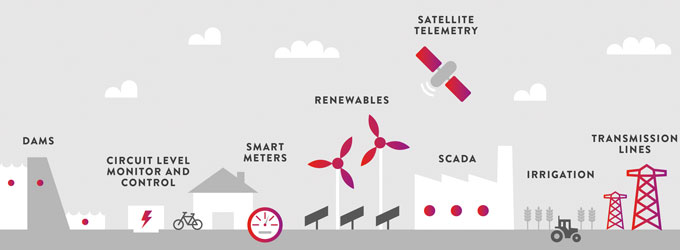
Water managers and power generators typically collect large amounts of information to help them make decisions. Organisations are also increasingly using sophisticated monitoring and communications technologies to make assets ‘visible’ around the clock and remotely, to achieve better results with less worker time, effort and travel.
However, these valuable sources of information are usually stored in disparate systems or repositories, including SCADA, telemetry, GIS, document repositories, field notes and CCTV systems. As well, these systems often predate the Internet, and, as a result, may not be easily or securely accessed, and may be confined to office or station networks.
For this asset data to yield insights and optimise operations, the different sources of information need to be unified and displayed in meaningful ways that add value to the basic data.
Managing data to maximise water flow for hydropower generation
Entura worked with its parent company Hydro Tasmania, Australia’s largest water manager and producer of renewable energy, to tackle this data challenge in relation to the canal system that brings water to Tarraleah, a hydropower station in the central highlands of Tasmania.
Managing the flow of water into the canal system is critical for maximising the available water to Tarraleah (and hence its capacity to generate valuable electricity), as well as maintaining the station’s safety and reliability.
As a canal is not a natural waterway, one might assume that keeping it running at the highest possible water level should be easy and predicable. However, the combined effects of uncontrolled inflows, automatic pumps, and unwanted plant growth in the canals make management of water levels in these canals much more complex.
Water levels can rise unexpectedly, spilling valuable water and potentially damaging infrastructure such as roadways or even the canals themselves.
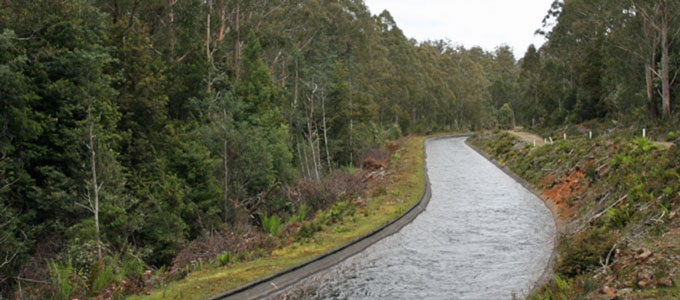
To achieve more efficient and remote management of the water flow into the Tarraleah canal system, Hydro Tasmania aimed to embrace and integrate the latest technology to monitor the live condition of the canals through SCADA, telemetry and manually read data, and make this data more readily available via a single online interface.
The first step towards this goal was understanding the existing limitations of the available information and access to data. GIS provided an excellent overview of the canal system, and was relatively straightforward to use and access via a web browser, but it did not contain any real-time or historical time series information.
The telemetry system contained some information about monitoring sites, but very little about how the data related to other aspects of the system. Also, it could only be accessed from specific computers, and required training and expert knowledge to use. The SCADA system recorded its data to an interface which provided little information about site relativity or purpose, and the interface could only be used within the power station. Some of the more valuable information about the canal system was kept by engineers in isolated document repositories.
These issues acted as barriers to understanding the canal system, hindered the ability to explain it to other people, and made it difficult to find the appropriate data for analysis.
Developing a data solution
To make Tarraleah’s canal information more useful, a data solution had to be interoperable, real-time, secure, synchronised, spatially integrated, contextualised and meaningful, and cost-effective.
| interoperable | To achieve interoperability across multiple devices and operating systems, a web-based platform provided the most suitable and cost-effective solution. A standards-based approach was used in developing the interface, so that the resulting system was able to work seamlessly across devices, with data accessible through a single user interface on laptops, tablets and smart phones. |
|
real-time
|
‘Seeing’ the status of infrastructure in real-time called for the data being displayed to be as current as possible, with each point in the chain of data transfer eliminating any unnecessary latency. Performance between the source of the data and the server was streamlined, and latency between the server and the user device was minimised through WebSockets, a new technology using highly efficient two-way binary connections to transfer data with minimal overhead. This allowed an extremely efficient flow of data (less than 500 ms). |
| secure | It was essential that the design did not introduce security risks for the sake of efficiency. To maximise efficiency and minimise security risks, all data was collected from the source and pushed over encrypted links via proxy servers to a cloud server, where it could then be pushed to the waiting client devices. The cloud provider chosen to store the data was considered one of the more secure in Australia, and one of only a few to feature the highest security certifications required by large utilities and mining companies. The software architecture used best-practice methodologies to isolate the data and keep it secure. |
| synchronised | With data stored in a variety of different systems, and ranging from real-time to historical, multiple systems required synchronisation, which was achieved via a configurable ‘data bridge’ solution using plug-in architecture. |
| spatially integrated | The system collated large amounts of spatial information, from maps or GIS or other business systems, into simple reusable formats for display. This required a versatile web-based mapping platform, with the ability to represent the canal, indicate its water level, represent and describe work orders, and link to other internal systems and information to allow easy visualisation of that item of work. |
| contextualised and meaningful (via metadata) |
With thousands of different data sources under management, the system needed to classify data so that users of the system could easily locate data relevant to their requirements. Meta tree structures were used to classify all the data, allowing hierarchical associations. Each data source was tagged with multiple different types of metadata (such as state, scheme, power station, data owner, site type, status), and grouping structures allowed nested grouping of information, such that users could filter information specific to their needs. The metadata structures could also be used to build dynamic security- sensitive dashboards of data, including any new data added to the system tagged with the appropriate information. This saves the time needed to configure dashboards, and makes sure all relevant data is available to the people that need access to it. |
| cost-effective | The system used technology that Entura had already developed to deliver similar projects for other clients, minimising the need to develop new software. The system itself is ‘cloud’-based, allowing the cost of the infrastructure to be shared among a larger group of customers. |
Simplifying access to data is helping Hydro Tasmania maximise the day-to-day operational efficiency of the Tarraleah canals, make better long-term operational decisions, and reap enhanced returns on investment. Employees now have a live view of the canals on iPads or tablets, enabling them to ‘tune’ the canals for maximum efficiency.
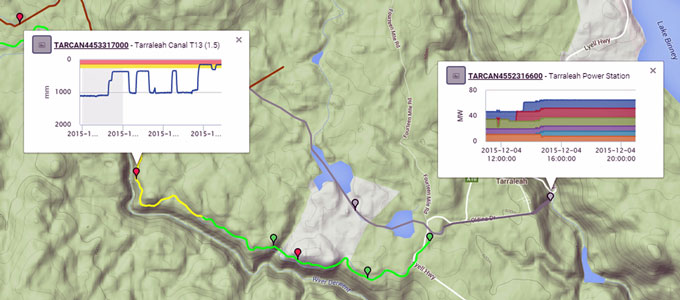
Similar solutions to those developed for this project can be used by power and water asset owners and managers to solve a range of data management challenges, including monitoring remote power stations, forecasting floods, and managing irrigation storages.
When we overcome barriers such as restrictive technologies and lack of metadata, we can make the most of our data. Interlinking multiple sources of information and displaying the results meaningfully leads to smarter decision-making and greater insights into how to operate our assets for maximum efficiency and value.
To discuss how Entura can help you manage your data to reap greater operational rewards, contact David Fuller on +61 438 559 763, Phillip Ellerton on +61 439 010 172 or Patrick Pease.
MORE THOUGHT LEADERSHIP ARTICLES
Getting the bigger picture from your data
Like having a pile of puzzle pieces but no box, are you drowning in data but unsure what it is telling you about your power and water assets?
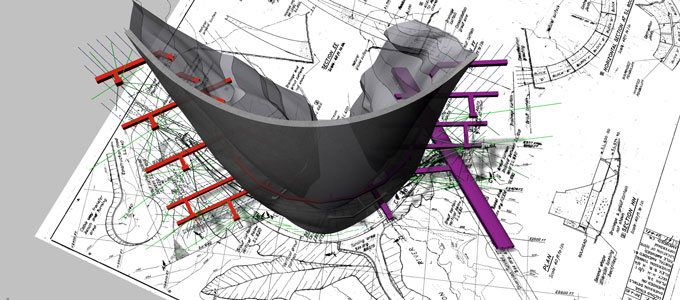
Gathering and interpreting complex data to detect emerging problems is an important aspect of asset safety worldwide. Avenues for collecting data are becoming more sophisticated and accessible and less expensive. We routinely gather data and explore data gaps, data quality and data processing, but how often do we rethink the fundamentals of presenting and communicating data?
For data to be useful, it has to help us diagnose issues and design solutions to keep our assets, our operators, and the public, safe. To do this, it must be understood. Traditionally we have used 2D methods to present data, but forming a picture of an asset from 2D information is very time consuming, often requiring site visits and hours exploring drawings, drill logs and construction photos to understand the complexities of the asset’s design and construction.
Because we have evolved in a 3D world and our senses have evolved to match, the human brain has significant and sophisticated resources dedicated to visual processing and understanding objects in three dimensions. This makes 3D models a naturally efficient medium for rapidly displaying, interpreting and communicating complex information relating to our assets.
Bringing data to life
With advances in technology, we are now able to quickly convert raw data to build 3D models from 2D drawings, and also to animate data in 3D to show change and movement over time. In 3D, assets can be quickly visualised and explored digitally from any angle. This spatial representation allows us to see important things that may otherwise be hidden, or not stand out, in the context of the overall design and layout of an asset.

Features normally hidden can be drawn into a 3D model, such as internal layouts or features under the ground. These can all be independently switched on and off, so that elements critical to the analysis can be considered individually, or contextually against other features to get the bigger picture.
With 3D information at their fingertips – whether on desktops in the office or on smartphones or tablets in the field – engineers, data analysts or field inspectors can better understand assets in significantly less time, reducing costs, complications and misunderstandings.
Time changes everything
To understand our assets, we rarely look only at the here and now. Change is the key to identifying and preventing potential failures or problems – so we must look carefully at past and present data and continue to watch our data into the future. In the past, representing change over time could only be economically achieved in 2D because manually updating 3D models was laborious and time-consuming.
Specialist power and water consulting firm Entura has developed systems that allow data sets (from Excel, Access or other programs) to be automatically processed and displayed onscreen, producing 3D ‘snapshots’ or even animating data directly in 3D. The systems have been developed to allow quick tweaking of model parameters to show different data sets individually or in combination, to exaggerate movements where critical changes are too small to directly detect by eye, or to use colour coding to clearly represent critical parameters.
Perhaps the most significant advantage is that these models can be updated in a matter of minutes rather than days, by individuals with little or no CAD experience, simply by adding new data into the model’s database.
Should seeing always be believing?
Like any tool, 3D representations have some limitations. However, with experience and a little caution, the power of 3D representation can be fully exploited with minimal risk.
Just as 2D drawings can have mistakes or exclusions, 3D models are only as good as the data from which they are built. If incorrect drawings are used to build a model, or the wrong data is used in animations, 3D outputs will not represent the real world but may still look very convincing.
Like any engineering analysis, when 3D models are first produced, a clear review and approval process is needed, and model results must be verified against expected performance to ensure that the tool is robust and can be used reliably into the future.
The real challenges of complex assets
Entura has applied advances in 3D data modelling and presentation to support the management of a range of water and power assets including hydropower stations, water pipelines and dams.
In each of these three examples, 3D modelling delivered a comprehensive picture of system behaviour over time:
- Our use of 3D modelling to explore the movement of turbine plinths at Hydro Tasmania’s Gordon Power Station contributed to a clearer understanding of a pattern of ongoing movement. This helped to identify potential causes and inform future remedial works.
- Developing a 3D model of a steel pipeline made it much easier for an asset owner to understand and make decisions about the extent and possible causes of unwanted movement of the pipeline and its supports. Our model clearly indicated the extent of movement, leading to a targeted engineering solution that directly addressed the root cause of the problem without unnecessary investigation, over-design or delay.
- When we applied 3D modelling to a hydropower dam built on a geologically complex foundation including dissolvable limestone, the resulting model combined the dam’s foundation profiles, underlying geology and leakage rates, and animated 3D water levels in the foundation. The 3D model is helping the owner to quickly and fully understand the data and easily monitor the performance of this complex asset.
In each of these cases, new data can be quickly integrated, allowing easy ongoing monitoring and clearer communication of the current and likely future behaviour of these assets.
With a bit of caution and experience, 3D data presentation tools can offer powerful benefits to asset owners and their stakeholders, putting all the pieces of the data puzzle together to quickly and easily reveal the full picture of an asset’s condition and performance over time, supporting decision-making for cost-effective and timely maintenance and upgrades.
To discuss how Entura can help you get the full picture from your data to better understand and manage your assets, contact Phillip Ellerton on +61 439 010 172 or Shekhar Prince on +61 412 402 110.
MORE THOUGHT LEADERSHIP ARTICLES
Prioritising safety at Rouna 2 hydropower station, PNG
As the saying goes, ‘safety doesn’t happen by accident’.
The measures taken to address safety risks at the underground Rouna 2 hydropower station in Papua New Guinea offer a timely reminder of the basic requirements for adequately managing safety risks and protecting workers when upgrading older hydropower stations or when developing new ones.
The upgrade of Rouna 2 – including adequate exits, flood protection, fire and smoke detection and control, and emergency management – illustrates that much more than just the main generating equipment needs attention to adequately identify and address safety risks and hazards in a hydropower station.
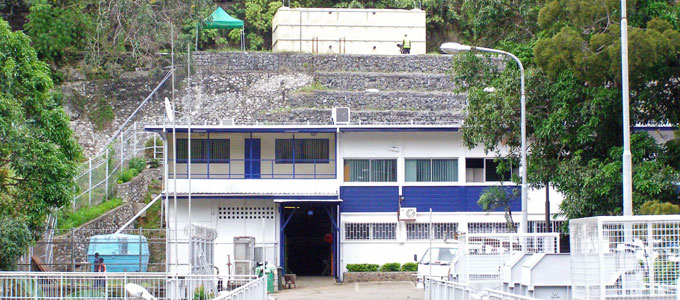
A run-down, risky hydropower station
Rouna 2 is one of four stations operating in a cascade down the Laloki River. It has five 6 MW vertical-axis hydro units from the late 1960s housed in an underground machine hall. Although only a small station, Rouna 2 has all the complexity and requirements of a much larger station.
By the time specialist power and water consulting firm Entura began working on the project to upgrade Rouna 2, the power station was old, run down by years of hard work, and was presenting its owners and workers with safety risks typical of many older hydropower stations.
The initial project concept was simply to refurbish the machines, but it quickly became clear that repairing or replacing only the generating units wasn’t going to be enough to sustain the power station’s operation, and that safety concerns needed to be urgently remedied.
Upgrading station evacuation
The Rouna 2 power station originally had only one access and exit route for the underground machine hall via open stairs in a 200 metre-deep vertical access shaft. No alternative emergency exit route was available. As the access shaft also contained all the power and control cables, it further intensified fire and safety risks.
To improve evacuation, a new emergency escape route was created via new ladders and platforms down the tailrace surge shaft to the tailrace tunnel, which normally carries water out of the power station.
Within the machine hall, the emergency escape route was made safer by being enclosed and made fire resistant, and kept smoke-free by a fan started automatically. Smoke hoods (emergency evacuation masks that reduce the risks of inhaling toxic smoke and gas) are provided to offer temporary protection for personnel needing to cover large distances to the start of the safe escape route.
To provide adequate lighting and signage for emergency escape, the DC-powered emergency lighting was upgraded. Evacuation alarms were improved, including strobe lights as well as audible sirens.
Improving flood protection
An underground power station surrounded by huge quantities of water under high pressure is particularly vulnerable to flooding. Rouna 2 had poor flood protection and dysfunctional evacuation alarm systems.
The evacuation alarms were upgraded and linked to flood detection within the machine hall. An automatic flood protection scheme was implemented to shut down the underground generating units and close the surface intake gate.
Improving fire and smoke detection and control
Hydropower stations are at risk of fire because they are full of electrical equipment. The Rouna 2 station had no fire detection system and minimal fire protection systems, so urgent attention to all fire measures was needed.
New fire panels and a new fire detection system were installed, as well as a new fire-fighting water supply, fire hydrants and hose reels. Sprinklers were installed in the access shaft and the machine hall. Older carbon-dioxide-based fire-protection systems for generator fires were replaced with water-spray systems. Fire doors were rehabilitated to close automatically.
Implementing an innovative new ventilation system
Ventilation systems in hydropower stations seldom provide any adequate smoke removal, despite the dangers of smoke inhalation. Technical innovations in the upgrade of Rouna 2’s safety systems included methods for smoke control integrated with the station’s ventilation system and its new fire panels and doors.
We upgraded the ventilation and smoke exhaust system by automatically reversing the ventilation fans during a fire, so that they exhaust smoke from the machine hall to the surface, and draw fresh air back down into the machine hall. At the same time, automatic fire doors close within the machine hall.
A safer power station for a safer future
Although new, large hydropower developments typically embrace complex and comprehensive safety standards and features, around the world many older stations are seriously deficient, presenting hazards that urgently need to be identified and resolved. Through our improvements to its ancillary services and safety systems, Rouna 2 is no longer in this extreme risk category.
However, adequate safety facilities are not the only requirement to maintain a safe hydropower station. Workers need the knowledge to maintain safety features, equipment and systems, and the skills to use them effectively. Entura has provided contract operators and station managers to work alongside local employees to help improve emergency and crisis management systems, provide local training and build capacity to ensure that Rouna 2’s future promotes a safer power station and safer workers.
To discuss how Entura can assist you with assessing hydropower station risks or developing a hydropower safety program or upgrade, please contact Ambrose Canning on +61 3 6245 4212 or Shekhar Prince on +61 412 402 110.
About the author
Ambrose Canning is Entura’s Principal Consultant, Mechanical Engineering. He has more than 30 years’ experience working on hydropower and water infrastructure projects in Australia, New Zealand, Malaysia, Papua New Guinea, India, Nepal, Philippines and Indonesia. He specialises in all aspects of hydropower development and redevelopment, upgrade and rehabilitation. He also has expertise in aspects of water infrastructure, such as dam electro-mechanical and hydro-mechanical equipment, pipelines, valves, pumps, screens, gates, valves and bulkheads.
MORE THOUGHT LEADERSHIP ARTICLES
Safer hydropower stations for safer workers
“Practices related to dam safety are well-defined and accepted throughout the world. However, hydropower safety encompasses more than just the dam … while hydropower safety is of critical importance, there is little shared knowledge on good practices around the concept of hydropower safety.” – International Hydropower Association
Hydropower stations can pose significant safety risks to those who work in them, but there is no excuse for injury or death in our workplaces. Whatever the history or location of the hydropower station, safe plant and safe work practices are critical.
Developers, owners and operators of hydro plant all need a strong commitment to workplace health and safety, and the insight and vigilance to control safety risks. As the saying goes, ‘safety doesn’t happen by accident’.
The hazards of hydropower stations
Some of the hazards at hydropower stations differ from those at thermal power stations or commercial installations. For example, hydro stations typically have limited access and no natural lighting, lower floors are often below the outside water level, and many are underground.
Hydropower hazards include fire, explosion (e.g. of pressure vessels), electrocution, flood, entanglement, slips and falls, chemicals (e.g. sulfur hexafluoride, hydrogen sulfide) and hazardous products (e.g. asbestos), and asphyxiation (e.g. carbon dioxide).
The level of risk presented by each hazard is a combination of its likelihood of occurring and the consequences if it did occur.
Seven ways to make a hydropower station a safer place
Designing safety into hydropower stations
When designing and implementing a new hydro scheme, or when upgrading an existing station, we need to carefully consider the standard of workplace health and safety to be achieved and the scope of work necessary to achieve it. This means understanding the relevant legislation, building codes and standards, and the requirements of the insurer; and being clear about the responsibilities of all the parties involved (such as the designer, developer, owner and contractors).
But while standards, codes and guides are a good starting point, the final solution needs to be tailored for the particular circumstances and level of risk. Safety systems for hydro plant can be complex and sophisticated, but they can also be as simple and robust as appropriate for the hydro facility being protected.
The primary consideration should be to provide safety facilities to get personnel out of a hydro station safely before conditions inside become dangerous. The second consideration should be providing facilities to get people out safely after conditions become dangerous. Only thirdly do we think about safety facilities to prevent damage to plant.
Planning ahead to control risks
A general approach taken to minimise workplace risks to the lowest practical level involves planning ahead for prevention of workplace accidents, injuries and illnesses, by ensuring that systems of work are safe, equipment is safe and properly maintained, and employees receive health and safety information and training and are properly supervised.
This approach is usually expressed through a ‘hierarchy of controls’:
Safety upgrades for older hydropower stations
Typically, new hydro stations are well designed and comply with appropriate safety standards and local building codes. Larger hydro stations can have safety systems as complex and thorough as those in modern multi-floor commercial buildings. However, older hydro installations were often designed with little regard to safety, and now need urgent attention to comply with modern workplace health and safety standards.
While safety facilities are readily incorporated into new hydropower schemes, they may be more difficult to retro-fit into existing schemes. The scope of work will need to take into account the interfaces with existing facilities and the tailoring required to suit the specific site and location.
Sharing our hydropower safety insights
Entura is part of Hydro Tasmania, Australia’s largest producer of renewable energy and manager of more than 30 hydropower stations with an enviable safety record. As a specialist power and water consulting firm, we’ve applied this real-world experience of designing safe hydropower stations and upgrading older plants to meet modern safety standards as we work with clients all over the world to improve the safety of their assets.
In our experience, these four very important aspects of hydropower safety should be considered as a first step towards building good practice for designing and operating safer hydropower stations:
| Station evacuation | Whatever the nature of the crisis, people must be able to get out of a hydropower station safely. All stations should have at least two independent ways to exit. If one route becomes inaccessible, an alternative emergency escape route should always be available. Adequate lighting is essential for emergency escapes. |
| Flood protection |
Hydropower stations can and do flood. Failure of drainage pumps can lead to a slow increase in the water level and eventual flooding of the station. Alternatively, a plant failure and leakage that drainage pumps cannot manage can cause rapid flooding of the station. This makes high-water-level alarms, flood alarms and evacuation alarms a necessity for life safety. Flood protection schemes can be implemented to automatically close intake gates or hilltop valves and keep turbines operating to attempt to drain the headworks and penstocks of water to control flooding, and to automatically stop hydro plant before the water levels become critical. |
| Fire and smoke control |
For life safety, we need to detect fires as early as possible, prevent them from spreading, alert all personnel, and provide safe and well-lit means of evacuation as soon as possible. Smoke control and ventilation are also extremely important. Fire will rapidly fill a hydro station with thick, black, acrid smoke, which is often a far greater hazard to personnel than the fire itself, as it obscures vision (preventing occupants from finding safe escape routes, as well as hindering search and rescue operations). It can also asphyxiate or poison people well before the temperature of the fire or smoke causes injury. A holistic fire protection system needs to attend to the full range of passive measures (e.g. fire-rated construction materials and methods), active measures (e.g. sprinklers, venting, fire-fighting equipment) and operational measures (e.g. plans, systems and training for fire prevention and response). |
| Emergency and crisis and management |
Safety at hydro stations involves more than simply having the correct equipment or hardware present at the site. It involves an ongoing commitment by the owner, management, operator and employees to provide and maintain a safe and healthy work environment. This commitment should be documented in writing and form part of a workplace health and safety policy supported by safe work systems and documentation. These should include a written risk control program and fire protection program, hazard register, site induction procedures, attendance boards, permit to work systems, local safety teams, and a detailed crisis and emergency plan. |
To discuss how Entura can assist you with assessing hydropower station risks or developing a hydropower safety program, please contact Ambrose Canning on +61 3 6245 4212 or Shekhar Prince on +61 412 402 110.
About the author
Ambrose Canning is Entura’s Principal Consultant, Mechanical Engineering. He has more than 30 years’ experience working on hydropower and water infrastructure projects in Australia, New Zealand, Malaysia, Papua New Guinea, India, Nepal, Philippines and Indonesia. He specialises in all aspects of hydropower development and redevelopment, upgrade and rehabilitation. He also has expertise in aspects of water infrastructure, such as dam electro-mechanical and hydro-mechanical equipment, pipelines, valves, pumps, screens, gates, valves and bulkheads.
MORE THOUGHT LEADERSHIP ARTICLES
What is the best dam type for my dam site?
Asking ‘what is the best dam type for my dam site?’ is a key question in the early stages of planning a dam project.
A number of dam types are being used around the world, such as concrete-faced rockfill dams (CFRD), roller-compacted concrete (RCC) dams, and asphalt-core rockfill dams, amongst others. Consultants that specialise in a particular dam type may offer a biased answer to the question, which is not in the best interests of the project.
The most appropriate response is that the best dam will depend on the unique characteristics of the dam site – available materials, climate, geology, topography, river flows, seismic risk – just to name a few. This may sound obvious, yet it is surprisingly often ignored.
Although it is important that we take our experience and learnings from other projects and apply them to any new dam project, it is equally important that we do not force a past solution to fit a new dam site without considering that particular site’s uniqueness.
So, for any dam site, it is important to undertake an unbiased dam-type assessment that takes into account the range of site-specific conditions balanced against the broader project constraints (such as cost optimisation, and the availability of local design and construction expertise).
The following examples of dams with which I’ve been involved show how particular characteristics of each dam site determine the appropriate dam type.

Responding to local climate, geology and materials in Tasmania
On the west coast of Tasmania, Australia, where the rainfall is around four metres per year, Hydro Tasmania, Australia’s largest renewable energy producer and water manager, has constructed nine CFRDs. Good rockfill was available at all of these sites. Key reasons why CFRDs were used at these sites, rather than central-core earth and rockfill dams, included both the lack of quality clay material and the high rainfall in this region. High rainfall would significantly disrupt and delay the construction of clay-core dams due to issues with the compaction of the clay material, whereas construction of CFRDs could continue during rain. Asphalt-core dams might also have been possible in these local climate conditions, but would have presented different challenges for river diversion.
One of these CFRDs, the 82m-high Crotty Dam, faced potential instability should a traditional side-channel spillway be cut into the abutment slope, due to the steep abutment slopes and identified geological defects. As a result, for the first time in the world, a spillway was created over the top of a high CFRD wall, combined with a large-capacity bottom outlet gate installed in the diversion tunnel. This solution included an articulated concrete slab that would allow the spillway to move without cracking as the rockfill settled over time.
The solution at Crotty Dam was unique, but it was heavily influenced by the characteristics of the dam site and the construction materials available, which allowed a very stiff rockfill to be constructed, minimising the amount of settlement. The solution has proven a good choice, operating well for more than 20 years.
However, the particular solution that was successful for Crotty Dam may not be appropriate for other dam sites, where the dam might be significantly higher, where rockfill may be of poorer quality, or at a site with greater flood discharge or higher seismic risk.
A process of elimination in Papua New Guinea
In 2012, Entura undertook a detailed dam-type assessment for a site in Papua New Guinea, and in this case, the ultimate decision about the best dam type emerged from considering many site characteristics and then eliminating inappropriate dam types to reach a subset of viable possibilities.
The site was in an extremely high rainfall area (with approximately ten meters of rain each year), the rock foundation had relatively low strength and low stiffness, river flows were consistently high, there was deep alluvial material that would need to be removed or sealed, and the site was in a region with relatively high seismic risk. Sources for concrete aggregate and rockfill were available. However, due to the lack of strength and stiffness of the foundation rock, a conventional concrete gravity dam was not possible; and the extremely high rainfall posed significant challenges for a central clay core and rockfill dam.
As a result, the choices narrowed to a CFRD, an asphalt-core rockfill dam or a thick, trapezoidal RCC (or hard-fill) dam. Ultimately, an asphalt-core rockfill dam was chosen as the preferred solution, as the core could be placed during high rainfall, the load would be adequately spread over the foundation, and it was considered a resilient design for the seismic loading.
Another important factor influencing the choice was that an asphalt-core rockfill dam would minimise problems and delays should the upstream temporary cofferdam overtop, because asphalt-core rockfill dams are always complete up to the current height of construction with no further work required below this level. Some other dam types require further work on the dam’s upstream face after the dam wall is constructed to its full height, requiring flood water to be pumped away to enable final-stage activities to proceed.
![]()
Challenges influencing RCC dam design and construction
Many design and construction decisions for RCC dams can be significantly influenced by specific site conditions – for example, should the proportion of cementitious material (cement and fly-ash) in the RCC mix be low or high? Should one use conventional facing concrete, grout-enriched RCC or a PVC upstream membrane? Is RCC best delivered by truck or conveyor?
A significant influence on the design of the Wyaralong Dam in Queensland was the benefit of using an onsite, but inferior, sandstone aggregate for the RCC aggregate. Using the onsite aggregate would reduce costs and benefit the local community through avoiding major aggregate haulage on public roads.
Using the onsite aggregate also influenced the investigations that occurred as part of the normal trial program used to develop an appropriate RCC mix. This in turn influenced the design of the dam because the trial mix program identified an issue with the surface durability of the RCC. Grout enrichment of the facing RCC was not suitable, so a conventional concrete using a high-quality basalt aggregate was used to provide the necessary durability.
The topography of the left abutment provided a natural ramp for an articulated truck delivery system. This delivery system proved to be very flexible, but it was important to develop a suitable RCC mix for truck delivery.
One size doesn’t fit all
There is no easy or immediate answer to the question posed at the start of this article. No single dam type offers the best solution for every dam site. Although lessons learnt from other dam sites can help to rapidly narrow down a set of preferred dam types to consider in more detail, the appropriate dam type must be influenced by the unique conditions of the dam site.
Specialist power and water consulting firm Entura has significant experience with a wide range of dam types across the Asia-Pacific and southern African regions, particularly CFRDs and RCC dams.
You can read more about the way in which we responded to specific site characteristics for three RCC dams and the reasoning underpinning our design decisions in my 2012 ICOLD Conference paper “Unique challenges influencing the design and construction of three recent Australian RCC dams”.
If you would like to discuss how we can assist you with selecting the most appropriate dam type for your dam site, please contact Richard Herweynen on +61 3 6245 4130 or Shekhar Prince on +61 412 402 110.
About the author
Richard Herweynen is Entura’s Technical Director, Water. Richard has three decades of experience in dam and hydropower engineering, and has worked throughout the Indo-Pacific region on both dam and hydropower projects, covering all aspects including investigations, feasibility studies, detailed design, construction liaison, operation and maintenance and risk assessment for both new and existing projects. Richard has been part of a number of recent expert review panels for major water projects. He participated in the ANCOLD working group for concrete gravity dams and is the Chairman of the ICOLD technical committee on engineering activities in the planning process for water resources projects. Richard has won many engineering excellence and innovation awards (including Engineers Australia’s Professional Engineer of the Year 2012 – Tasmanian Division), and has published more than 30 technical papers on dam engineering.
MORE THOUGHT LEADERSHIP ARTICLES
Breathing new life into ageing assets: asset management in practice in PNG
The remote Ok Menga hydropower station in the Western Province of Papua New Guinea is vital to the operation of the Ok Tedi mine (OTML). It offers an example of just how expensive it can be when ageing power stations deteriorate and become increasingly unreliable.
The Ok Menga hydropower station provides almost three-quarters of the power needed to operate the mine, with the remaining power generated using expensive diesel fuel. The local power network is isolated and not connected to any of the country’s electricity grids, so any failure of the Ok Menga power station is costly.
If one of Ok Menga’s two generating sets is out of action, replacing that amount of hydropower (about 30 MW) with diesel-generated power could cost around AUD$650 000 a day in fuel alone. Worse still, a full outage of the power station could cause the mine to shut down, losing copper, silver and gold production worth around AUD$4 million per day!

The Ok Tedi mine had been scheduled to close in 2015, so preventative maintenance had not been a high priority for its owners, and the Ok Menga power station had become run down. When the mine’s proposed closure was delayed to 2025, a new operational strategy was needed to wring at least another ten years of useful and reliable life out of the more-than-30-year-old Ok Menga power station.
OTML needed the help of skilled asset management experts to extend the life of the Ok Menga power station, so it engaged specialist power and water consulting firm Entura to conduct an extensive condition assessment and come up with a risk mitigation plan to get the best out of the station in a cost-effective way. This also included building the skills and knowledge of OTML staff who had not had any formal training for years.
Ok Menga’s unique challenges
Although Ok Menga had many of the same asset management issues as any other hydro plant, it also presented some unique challenges in terms of risks and maintenance strategies. Its isolation and association with a large mining operation challenged many of the conventional rules fundamental to asset management in larger power utilities.
Leigh Smith, specialist consultant in asset management at Entura, explained: “In our asset management approach, we needed to take into account how the particular characteristics and circumstances at Ok Menga created differences for aspects such as the design life, planning outages, access to the plant, the holdings of critical spare parts, and the consequences of faults. For example, because outages at Ok Menga incur such high costs, we needed to replace rather than refurbish machinery, because they couldn’t have the machines offline for long.”
Bringing risks under control
Entura applied its best-practice asset management approach at Ok Menga by thoroughly assessing the condition, performance and remaining useful life of all aspects of the station, and developing a risk mitigation plan including urgent actions to remedy serious risks, and ‘quick wins’ to improve the state of the station quickly, cheaply and effectively.
As Leigh explained, “We report the condition of the plant in terms of business risk, and the mitigation strategies we propose are all about reducing risk to a level that’s acceptable to the business in cost-effective and practical ways”.
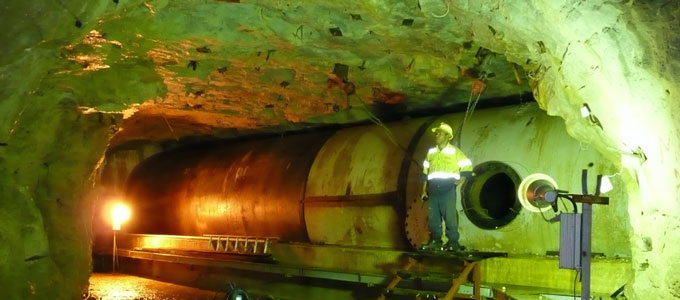
Quick wins and priority actions
At Ok Menga, two ‘quick win’ projects were identified to mitigate critical risks. The main inlet valves were difficult to access and in poor condition with no critical spare parts on site, and the original analogue turbine governors installed in the 1980s needed replacing but no governor spare parts were available.
“A failure in either or both of these areas was seen as likely in the foreseeable future and would create serious consequences of a prolonged forced outage for one unit or even the complete station,” said Leigh.
Replacements for the main inlet valves would take more than 18 months to deliver, so an emergency repair kit containing critical spares was ordered immediately. Replacement of the governor controllers with newer digital technology was also rapidly initiated to quickly reverse declining reliability.
Leigh said, “Getting these ‘quick win’ projects going straightaway was imperative and immediately reduced very significant risks.”
As well, at Ok Menga, three priority asset risk mitigations were identified relating to the station’s rock trap, unit 1 turbine and the dewatering and drainage system. The rock trap was found to be full, and cleaning it out was initiated quickly. Ok Menga’s unit 1 turbine was worn so the unit 1 runner and cassette were replaced. The security of the dewatering and drainage system had been degraded and it was at risk of failure so Entura recommended that it be upgraded to a system with greater reliability and redundancy.
“Because these priority actions minimised damage to turbines, avoided possible turbine malfunction, and reduced the risk of the powerhouse being flooded, they made a big contribution to reducing the owner’s overall risk exposure,” said Leigh.
![]()
Building capacity
To fill skill gaps at the Ok Menga power station, Entura developed an Australian-accredited program to train new and existing hydro operators. Local staff were included in the asset management process and have now had first-hand exposure to best-practice techniques.
“The owner of this power station is very committed to a sustainable future, and this extends to its staff. The platform is now set for local staff to build on their newfound knowledge and continue to improve their understanding and skills in asset management,” explained Leigh.
Entura has developed its knowledge of asset management through our involvement over the past 100 years with the extensive power and water assets of Hydro Tasmania, Australia’s largest renewable energy producer. Our approach to asset management is recognised as best practice.
“We have spent considerable time learning and developing our systems and knowledge, and this enables us to deliver cutting-edge asset management techniques to our clients without the expense they’d incur if they started from first principles,” said Leigh.
Entura’s holistic best-practice asset management approach at the Ok Menga power station delivered a range of benefits including reducing immediate and longer term risks, and increasing the knowledge and skills of local staff – saving OTML the time and cost of developing its own in-house programs.
If you would like to discuss how Entura can assist you with assessing your hydropower plants or other power or water assets to minimise risk and maximise efficiency and useful life, please contact Leigh Smith on +61 419 884 318 or Shekhar Prince on +61 412 402 110.
MORE THOUGHT LEADERSHIP ARTICLES
Less risk, more benefit: managing assets for long-term gains
Hydropower stations, like all technology or infrastructure, won’t stay efficient, reliable or safe without regular and ongoing attention.
Outages and failures caused by ageing or deteriorating infrastructure can be extremely expensive and serious, and far outweigh the costs of a well-targeted asset management plan. The costs of unreliability are even more significant for hydropower stations in isolated locations or where the power is relied on to run industrial or commercial operations.
But asset management isn’t only about avoiding disasters … It’s also about getting the most out of asset life or ‘getting more bang for your buck’. Owners and operators stand to reap rewards from improved performance and greater reliability if they protect and extend the lives of their investments using best-practice asset management techniques.
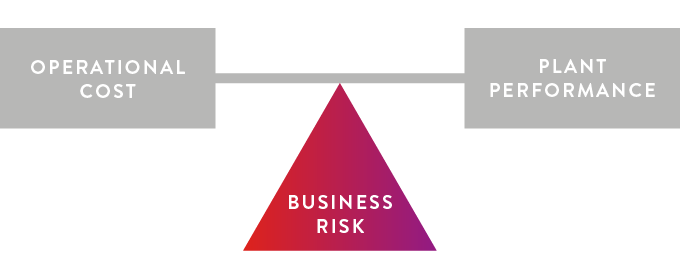
From basic to best practice
In today’s industry, significant amounts of time, energy and effort are invested in achieving desired plant performance at the lowest possible cost without exposing the business to unacceptable risk. Truly sustainable and successful businesses have found ways to balance these priorities, and have strategies in place to adjust the balance as needed when facing changing conditions.
Besides the large financial consequences of outages, failures of systems and equipment can also place the lives of workers at risk. Repairing and upgrading equipment and systems only after they fail is an extremely costly and dangerous way to manage assets. This kind of basic ‘breakdown-oriented’ or reactive asset management is likely to result in unreliable plant and increased human and financial risks.
As businesses mature in their approach to asset management, they progress from a breakdown-oriented approach, through reactive and corrective approaches, towards preventive, predictive and proactive approaches.
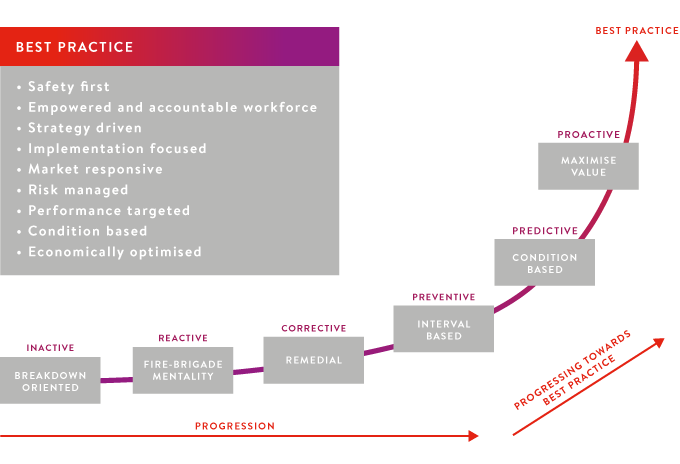
Best-practice asset management focuses on reducing risks and improving condition and performance to get the best results. It is driven by strategy and responds to the market, empowers the workforce and makes workers accountable, and always puts safety first. It also needs to be flexible enough to accommodate the individual characteristics of different hydropower stations.
Save time, save money, save lives
Specialist power and water consulting firm Entura thoroughly understands the complexities and benefits of asset refurbishment, upgrade, modernisation and extension of life. As part of Hydro Tasmania, Australia’s largest renewable energy producer and water manager, Entura has day-to-day experience of the challenges of maintaining and upgrading assets to get the best performance, reliability and economy over the long term, through dealing with 30 hydropower stations built and maintained over the past 100 years.
Entura’s asset management techniques are based on condition, performance and risk – designed to save companies time and money. This approach is underpinned by an optimised system that combines reliability-centred maintenance (RCM) and failure modes and effects analysis (FMEA) using generic failure mode databases that can be applied to various different assets with quick results.
Entura’s asset management approach has helped other asset owners across Australia, New Zealand, Papua New Guinea and Malaysia to reduce their costs, reverse declining reliability, obtain better returns through increased performance and improved technology, increase personnel safety, decrease fire and flooding risk and other hazards, increase skills of their staff, and ensure the long-term viability of their valuable infrastructure.
Three steps to best-practice asset management
Entura’s approach to best-practice asset management has three steps that fully consider your assets’ past, improve their present operation and risk profile, and position them for their best possible futures.
Step one: Assessing assets
To fully assess an asset, we undertake detailed inspections and consider the four parameters of:
- condition (observed and measured condition, and maintainability, which takes into account the availability of spare parts, technical ability, and industry compliance)
- performance (both capability and reliability)
- confidence (the level of detail or rigour of the assessment)
- remaining useful life (an estimate of the rate of deterioration of the asset, indicating where the particular asset is on its lifecycle curve, and whether a refurbishment or upgrade can improve its position on this curve, even effectively returning it to as-new condition).
We present a high-level ‘water-to-wire’ summary of the condition and performance assessment results that quickly and graphically displays the known asset condition and remaining useful life, and identifies components for which the condition is not adequately known.
Step two: Developing a risk and mitigation plan
Once an asset has been fully assessed, we develop a risk and mitigation plan.
First, we gather and review a comprehensive set of information on the operation, design and construction of the station and its assets. We explore both the asset history and generic databases to determine probable failure modes.
Once we’ve gathered this information and analysed it against the requirements of the power station, we report the known condition of the plant in terms of business risk and develop practical and cost-effective mitigation strategies to reduce risk to a level that is both achievable and acceptable for the business.
We identify and undertake mitigation actions including ‘quick wins’ (actions that can be undertaken quickly and easily to achieve major improvements) and immediate priority activities to reduce risks. We also detect assets or components that need further investigation.
Step three: Optimising future performance (tailoring the balance)
Best-practice asset management takes a broad view of the life and operation of an asset, not only reducing immediate risks, but also promoting long-term efficient performance and sustainability. Our approach optimises the capital and operational costs over the remaining life of the asset.
A valued part of Entura’s asset management approach is our ability to offer a review of likely efficiency and capacity gains, and other general suggestions for improving performance and systems.
An important step in our holistic approach to achieving long-term safety, reliability and efficiency is training local hydro operators to fill any identified skill gaps and better safeguard the maintenance of assets. We build the capacity of our clients through on-site or formalised training through our Entura clean energy and water institute.
If you would like to discuss how Entura can assist you with assessing your hydropower plants or other power or water assets to minimise risk and maximise efficiency and useful life, please contact Ambrose Canning on +61 3 6245 4212 or Shekhar Prince on +61 412 402 110.
About the author
Ambrose Canning is Entura’s Principal Consultant, Mechanical Engineering. He has more than 30 years’ experience working on hydropower and water infrastructure projects in Australia, New Zealand, Malaysia, Papua New Guinea, India, Nepal, Philippines and Indonesia. He specialises in all aspects of hydropower development and redevelopment, upgrade and rehabilitation. He also has expertise in aspects of water infrastructure, such as dam electro-mechanical and hydro-mechanical equipment, pipelines, valves, pumps, screens, gates, valves and bulkheads.
MORE THOUGHT LEADERSHIP ARTICLES
Dam safety: protecting lives and driving efficiencies
Humans have been damming rivers since 3000 BC for water retention and supply.
People can fish in the lakes formed by dams, sail on them, swim in them. They are important to life, providing water supply, irrigation for crops and power generation. But if a dam fails, causing devastating flooding downstream, the results can be catastrophic.
The worst dam failure in history occurred in China in 1975 when the Banqiao Reservoir Dam and other dams in Henan province failed, killing an estimated 171 000 people, with 11 million people losing their homes.
Safety is the key
Dam safety is a crucial aspect of modern dam building. Ensuring the safety of existing dams is a key concern of any dam owner, whether the dam is for generating power, protecting a nearby population from potential flooding or for the age-old reason of water supply.
Specialist power and water consulting firm Entura provides dam safety programs for Gordon Dam, the largest concrete arch dam in Australia, and other assets owned by Entura’s parent company, Hydro Tasmania, and for government and corporate clients around Australia, south-east Asia and southern Africa.
Hydro Tasmania is Australia’s largest water manager, so it needs to ensure that the risk of a failure across the portfolio is very, very small. With 55 large dams and many smaller ones, Hydro Tasmania needs to be able to identify the highest risk dams, so it is able to prioritise work on maintenance and refurbishment. This is achieved using a process undertaken by Entura called a portfolio risk assessment (PRA).
Hydro Tasmania is committed to the safety of its assets for the people of Tasmania and its PRA enables the business to prioritise where it focus its financial resources, management and dam safety efforts.
What’s the level of risk?
Energy and water asset owners are increasingly choosing to implement a dam safety program to quantify and manage operational risks, evaluate high risks and find solutions for identified risks or deficiencies. Entura believes that a risk-based framework like a PRA is the best way to achieve an efficient and effective dam safety program.
Older dams or dams located upstream from populated areas are often high risk. The inspection regime for high-risk dams is understandably more robust and rigid than for low risk dams. However, it’s not just ageing that creates risks for dams. In Australia, the methods used to predict and anticipate floods are equally important, as is the increased knowledge that we’ve gained of the various causes and mechanisms through which dams can fail.
Entura’s PRA reviews the consequences of failure of a dam by looking at the impact that it may have on downstream populations, and also looks at the chance of failure occurring by considering extreme events such as floods and earthquakes, taking into account the specific site conditions. It is the combination of the chance of failure with the resulting consequence that determines the level of risk.
A world-wide issue
A number of dam owners across the Asia-Pacific region are now looking at Entura’s PRA program, especially when they have a significant dam portfolio already developed. Our clients in the region are exploring how they can best use their resources and how to prioritise expenditure on their assets.
Having undertaken safety reviews and dam safety work in the Philippines, China, Indonesia, Malaysia, New Zealand, Papua New Guinea, Fiji and India, Entura understands the typical safety needs and drivers of dam owners across the world.
Australia has well-developed dam safety legislation in which Malaysia, for example, with its increasing number of dams, is very interested. Malaysia has experienced the tragic results of a dam safety incident, with the death of a number of people due to water releases through the spillway gates of Sultan Abu Bakar Dam.
On behalf of the Ministry of Public Utilities, Sarawak, Malaysia, Entura used its dam risk framework, similar to that used in a PRA, to assess whether the Bakun and Murum dams were ready to be impounded as construction reached conclusion. This dam risk framework looked at the potential scenarios that could lead to the sudden release of reservoir water, the likelihood of these scenarios occurring, and the corresponding consequences. Through this process the key dam safety risks were identified, and actions were determined to either eliminate or reduce the risks to an acceptable level. These actions needed to be addressed prior to impoundment.
Dam safety is an ongoing concern
The safety and risk-level of a dam can change with time. As dams or assets age, the way they are managed needs to change and they often need upgrading to ensure continued safe operation and desired life expectancy. But undertaking upgrades can potentially increase the risk of the dam during the construction phase – due to the removal of shoulder material from an embankment, or restricting the discharge capacity in a spillway chute. To contain the risks during the construction phase, operational practices might need modification, for example, operating a dam at a lower lake level during the period of construction to ensure the overall risk is not significantly increased. This is why it is so important to have a plan to manage the safety of the dam during its entire lifecycle.
Five steps to assess dam safety risks
Risks can be reduced in a range of ways and, in many cases, a number of risk treatment options are used together:
- reducing the likelihood of the risk occurring (e.g. strengthen a dam)
- reducing the consequences if the risk does occur (e.g. upgrade emergency planning)
- staging risk treatments (e.g. address most cost-effective risk mitigation works first)
- balancing the resources required to treat a risk with the benefits of reducing the risk (e.g. examine various levels of investment and their respective risk reductions).
Entura’s portfolio risk assessment approach has five key steps:
| 1 – Flood hydrology | Flood hydrology is a key input as it is used in both the engineering and consequence assessments. Generally the hydrology is based on current best practice. For some low-hazard dams, an innovative regional flood hydrology approach has been developed that provides sufficiently robust answers at minimal cost. |
| 2 – Engineering assessment | The engineering assessment is a critical part of the process as it requires all potential failure modes to be identified and then the probability of failure to be estimated for each mode. The engineering assessment gathers all the information about the dam including design, construction, geology and operations that may assist in defining the potential failure modes. This is presented as response curves (i.e. conditional probability of failure). The level of detail varies with the hazard category of the dam (i.e. a high-hazard-category dam receives more intense scrutiny than a low-hazard dam). The engineering assessment also ensures an assessment of compliance with current engineering standards. |
| 3 – Consequence assessment | Key steps in the consequence assessment method include developing a dam break model; mapping the inundation zones; assessing the population at risk and probable loss of life; assessing the financial and economic losses; and qualitatively assessing the environmental, social and intangible consequences. |
| 4 – Risk assessment | The risk assessment uses event trees that evaluate societal and individual life risk and financial risks. Risks can be aggregated across a range of load conditions and failure modes to give a total risk position, retaining visibility of the scenarios that contribute to the total risk. Where the risks are unacceptable, upgrade concepts are developed and their impact on reducing risk is plotted. |
| 5 – Reporting | The results of the risk assessment are reported, summarising the potential failure modes, consequences and risk profile for each individual dam. Summary data across the portfolio is also presented, including information on the failure modes, and risk of all the dams against societal life risk and financial risk criteria in a simple but meaningful format. |
Resource levelling
All businesses need to share resources across many activities besides risk mitigation works. For a hydropower company, a significant reinvestment in generating plant is required to both manage risk and maintain asset capability. Resources are also needed for investment for growth and diversification.
Within the dam portfolio, it is important to ensure that resources, both human and financial, are not applied to risk mitigation projects at the expense of the fundamentally important surveillance and monitoring activities. A balance is needed between reducing risk and maintaining and enhancing surveillance and monitoring instrumentation.
An ongoing effort
Finally, it is important to realise that the capital works program for dam safety risk reduction is not a static program, locked in and then implemented without change. Rather, it is an active program that is reviewed regularly, actively managed and needs to remain responsive to new or changed risks, developing understanding of dams engineering, shifts in business priorities, delays to projects, and new developments in risk management processes.
The same process can be applied to other assets
The PRA process can also be used for other assets that have a low chance of failure but high consequences if failure were to occur. At Entura, we have successfully applied our PRA process to penstocks and pipelines, and to canal systems, identifying key risks and prioritising the actions needed in a way that most effectively manages resources.
If you would like to discuss how we can assist you with assessing your dam risks or developing a resource-effective and comprehensive dam safety program, or apply the same PRA process to other key assets, please contact Richard Herweynen on +61 3 6245 4130.
About the author
Richard Herweynen is Entura’s Technical Director, Water. Richard has three decades of experience in dam and hydropower engineering, and has worked throughout the Indo-Pacific region on both dam and hydropower projects, covering all aspects including investigations, feasibility studies, detailed design, construction liaison, operation and maintenance and risk assessment for both new and existing projects. Richard has been part of a number of recent expert review panels for major water projects. He participated in the ANCOLD working group for concrete gravity dams and is the Chairman of the ICOLD technical committee on engineering activities in the planning process for water resources projects. Richard has won many engineering excellence and innovation awards (including Engineers Australia’s Professional Engineer of the Year 2012 – Tasmanian Division), and has published more than 30 technical papers on dam engineering.
MORE THOUGHT LEADERSHIP ARTICLES
The hidden risks in hydropower projects
Hydropower is increasingly becoming a major source of renewable energy for emerging markets throughout Asia.
Managing the not-so-obvious risks associated with developing and operating hydropower schemes is often a key challenge in securing project finance and gaining or maintaining a social licence to operate.
“Power projects, especially in developing countries, are increasingly scrutinised by international financing organisations when providing project funding” said Dr Eleni Taylor-Wood, Principal Consultant, Environmental and Social Science at specialist power and water consulting firm Entura.
“These entities, such as the Asian Development Bank, the International Finance Corporation and the World Bank, recognise that growth must be both inclusive and environmentally sound to reduce poverty and build shared prosperity for today’s population and future generations.”
Managing risk across all stages of a project can improve the viability of a project and the overall project outcomes.
What are the risks?
It is critical that both governments and hydropower entities understand the opportunities and risks of major projects, not only at the development stage, but also throughout the ongoing operation and management of the scheme.
Typically, some of the key risks to be considered include:
- Is there an identified need, what is the future demand, and is there a market?
- What is the best energy option?
- Could any political or public sector issues affect the project?
- Is there the institutional capacity to advance the project?
- How available is the resource? Will climate change affect availability?
- Is the site appropriate? Are there other options?
- Can you connect into the grid, and where? What systems enhancements might be required?
- Who are the key stakeholders and how can they be engaged?
- What are the possible environmental and social impacts, and how can they be avoided, mitigated, offset or compensated?
- What safety issues are associated with development, construction and operation, and how can they be managed?
- What are the ongoing operational costs?
- What are the ongoing operational requirements, such as compliance requirements, condition assessments, performance monitoring, maintenance strategy and planning, and training to build operator skills?
- How will you manage unforeseen stakeholder, technical, financial, social and environmental issues?
Using international standards and sustainability assessment frameworks to manage risks
International standards and sustainability assessment frameworks can help guide a comprehensive review of risks and, in some cases, identify further opportunities to increase positive outcomes from projects.-
In 2010, the International Hydropower Association launched the Hydropower Sustainability Assessment Protocol, a framework for assessing the sustainability of hydropower projects across the world. This framework can be used to help guide a hydropower project from the early stages of consideration through to operation, identifying issues and gaps for consideration, as well as be used to assess the project’s sustainability performance.
There are only eleven accredited assessors able to officially apply the Protocol worldwide. Entura’s Dr Eleni Taylor-Wood and Dr Helen Locher are among this select group of accredited assessors, having undertaken assessments of hydropower projects in Europe, South Asia, South-east Asia and South America.
One step at a time
“Evaluating the risks in stages means that the cost of evaluation can be minimised should the project be judged unviable at any point. Not all risks can be avoided, but many can be minimised or mitigated,” explained Dr Taylor-Wood.
Early identification of key risks allows companies to manage these risks throughout a project, minimising corporate, technical, environmental and social impacts and their associated costs, including damage to corporate reputation should an unmanaged risk develop into a crisis.
Self-assessment and capacity building
“I believe that for hydropower developments to be sustainable, we need to use the lessons of the past to innovate in the present and protect the future,” said Dr Taylor-Wood.
“This means learning from mistakes and carefully assessing and managing technical, corporate, economic, environmental and social risks right across the project lifecycle, so that developments contribute positively to social, environmental and economic goals.”
Entura uses a unique, tailored self-assessment tool to assist power companies and developers to understand the risks and opportunities facing their projects and to build capacity to assess, monitor and report on those projects.
This tool is based on the assessment criteria identified in guidelines and standards such as the Hydropower Sustainability Assessment Protocol and those used by the International Finance Corporation.
In addition, it can be adapted to include other standards or to assess compliance with criteria relevant to a client’s requirements or obligations (such as internal policies and/or permit or concession conditions).
Benefits include easier access to finance, better ability to anticipate and respond to stakeholder concerns, and avoidance of delays and problems through the project development pipeline.
Entura provides expert advice to help clients:
- develop a better understanding of risk identification, assessment and sustainability, across all project stages
- self-assess a project against recognised guidelines and standards to identify whether key issues, risks and opportunities have been considered and identify potential gaps for further consideration
- meet international financing requirements
- assess viability or conduct a due diligence of a project
- undertake assessments against the Protocol
- address risk issues to improve the overall sustainability performance of projects
- build institutional capacity to develop, operate and/or maintain power schemes.
eleni.taylor-wood@entura.com.auIf you would like to discuss how we can assist you with assessing your project or how you can assess and track your own progress towards improved risk minimisation and sustainability, please contact Dr Eleni Taylor-Wood on +61 3 6245 4582 or Shekhar Prince on +61 412 402 110.
About the author
Dr Eleni Taylor-Wood is Entura’s Principal Consultant, Environmental and Social Science. Eleni has 20 years’ experience successfully managing large-scale, complex projects that run over several years, as well as providing expert advice and independent review for a range of infrastructure and planning projects. She has worked on projects around the world including in Australia, Mozambique, South Africa, Iceland, Colombia, India, Malaysia, Mekong, Solomon Islands, Fiji and Papua New Guinea. Her experience covers a vast gamut of studies including: environmental and social impact assessment and management; strategic management of wetlands and waterway; feasibility and approvals for new hydropower projects, environmental flow determination and assessment, and sustainability assessments. Eleni is currently one of eleven Accredited Assessors under the Hydropower Sustainability Assessment Protocol worldwide.
MORE THOUGHT LEADERSHIP ARTICLES
Reliable, renewable energy now powering South Africa
In many developing nations, governments and utilities are scrambling to bring much-needed power to their people and industries to improve quality of life and drive economic growth.
Small hydro (around 40 MW or under) from run-of-river schemes is an ideal solution to contribute to growing and greening the energy mix in developing countries, providing clean and reliable power from a country’s rivers without the significant environmental or social impacts of large dams or the economic and environmental costs of fossil fuels.
The Neusberg hydropower project – a run-of-river small hydropower project near Kakamas in the Northern Cape of South Africa – is one small but effective step towards South Africa’s ambitious goals of raising the living standards of its growing population and supporting vital economic activity through encouraging the development of renewable energy by independent power producers.
What is the Neusberg hydropower project?
Using the power of the mighty Orange River, the Neusberg hydropower project creates electricity by diverting some water for a short distance as it runs downstream from the existing Neusberg Weir, returning the water back to the river after it runs through the hydroelectric plant’s three 4010 kW turbines.
The Neusberg project is highly efficient, producing 10 MW of reliable and sustainable baseload power for the equivalent of up to 5000 homes with no adverse impacts on irrigation, fish or environmental flows.
Success through collaboration, innovation and expertise
The Neusberg project needed a particularly innovative design solution and effective planning and collaboration for it to meet the needs of the region, satisfy the requirements of all major authorities and stakeholders, and still achieve the objectives of the developer.
And that’s where specialist power and water consulting firm Entura drew on its extensive experience in hydropower development to find the right answers to move the project towards successful completion.
For example, developing all the necessary tender and contractual documentation and negotiating and achieving regulatory approvals are critical administrative steps but can prove challenging. Entura’s owner’s engineer services helped the Neusberg project overcome these development-stage hurdles – such as helping to achieve the vital water use licence by proposing suitable designs for the project and then working through a collaborative process to modify the designs to meet the authority’s requirements while still achieving the developer’s objectives.
Tailored solutions for tricky challenges
A major challenge for the Neusberg project was to produce economical and reliable power to relieve pressure on the electricity network at the same time as ensuring adequate water supply for irrigation by local fruit-growers throughout the construction and operation of the project. Other specific local requirements also needed to be met, such as maintaining the ability of the Neusberg Weir to meaningfully measure river flow, maintaining the aquatic environment and minimising the impacts from construction activities.
- To guarantee an uninterrupted supply of water to the local irrigation scheme, construction of the hydro project called for clever planning. Since an existing irrigation canal ran through the powerhouse site and needed to remain in operation, a temporary diversion canal was created to allow the powerhouse and forebay to be constructed in two stages without interrupting irrigation supply.
- To ensure that the flows into both the hydroelectric project and the irrigation canals are sufficient, a weir was placed at the offtake for the hydro project providing passive protection against the water level in the reservoir being drawn down. The level of the top of the weir was carefully designed so that the length of the weir was reduced – lowering construction costs while providing the protection required for the irrigation canal and allowing sufficient flow into the headrace canal.
- The Neusberg Weir is a very important flow measuring structure as it provides accurate information on the flow in the Orange River to both South Africa and Namibia. The hydro project takes water away from the weir, so to restore the ability to measure flows, two devices were installed – an instrument in the canal upstream of the powerhouse, and the weir in the tailrace. The measuring weir in the tailrace provided an extra benefit for the aquatic environment, by acting as a barrier to fish movement and enabling fish to find their way to the existing fish ladder to travel upstream.
- To minimise costs and impacts of construction, the design of the Neusberg project dispensed with the typical aboveground powerhouse structure. Instead, the concrete roof of the powerhouse has a removable hatch allowing equipment to be lowered through the roof by crane into the turbine chamber.
Community benefits both now and into the future
The Neusberg project has brought an ongoing social and economic boost to the local community that goes well beyond providing an important source of electricity. During the construction phase, it created much-needed local employment in a region in which opportunities are scarce, and supported local and national businesses through spending on goods and services.
But the benefits keep flowing long after construction is finished, as the local community has a
15 per cent ownership stake in the hydropower scheme and an 8 per cent stake in operation and maintenance contractors, ensuring that the community trust will share in the project’s success for many years to come.
Entura’s role in the Neusberg project
Entura has played a vital role in the successful civil design and was also responsible for the electrical and mechanical construction of the Neusberg project by drawing on our day-to-day experience of owning, operating and maintaining hydropower assets for more than 100 years as part of Hydro Tasmania, Australia’s largest renewable energy producer and water manager, and an equity stakeholder in the Neusberg project.
If you would like to discuss how Entura can help you develop a hydropower scheme that can meet your power needs in a cost-effective and sustainable way, please contact Christoff LeGrange on +27 21 202 2231 or Shekhar Prince on +61 412 402 110.

